
The Plagiarism Checker Online For Your Academic Work
Start Plagiarism Check
Editing & Proofreading for Your Research Paper
Get it proofread now
Online Printing & Binding with Free Express Delivery
Configure binding now
- Academic essay overview
- The writing process
- Structuring academic essays
- Types of academic essays
- Academic writing overview
- Sentence structure
- Academic writing process
- Improving your academic writing
- Titles and headings
- APA style overview
- APA citation & referencing
- APA structure & sections
- Citation & referencing
- Structure and sections
- APA examples overview
- Commonly used citations
- Other examples
- British English vs. American English
- Chicago style overview
- Chicago citation & referencing
- Chicago structure & sections
- Chicago style examples
- Citing sources overview
- Citation format
- Citation examples
- College essay overview
- Application
- How to write a college essay
- Types of college essays
- Commonly confused words
- Definitions
- Dissertation overview
- Dissertation structure & sections
- Dissertation writing process
- Graduate school overview
- Application & admission
- Study abroad
- Master degree
- Harvard referencing overview
- Language rules overview
- Grammatical rules & structures
- Parts of speech
- Punctuation
- Methodology overview
- Analyzing data
- Experiments
- Observations
- Inductive vs. Deductive
- Qualitative vs. Quantitative
- Types of validity
- Types of reliability
- Sampling methods
- Theories & Concepts
- Types of research studies
- Types of variables
- MLA style overview
- MLA examples
- MLA citation & referencing
- MLA structure & sections
- Plagiarism overview
- Plagiarism checker
- Types of plagiarism
- Printing production overview
- Research bias overview
- Types of research bias
- Example sections
- Types of research papers
- Research process overview
- Problem statement
- Research proposal
- Research topic
- Statistics overview
- Levels of measurment
- Frequency distribution
- Measures of central tendency
- Measures of variability
- Hypothesis testing
- Parameters & test statistics
- Types of distributions
- Correlation
- Effect size
- Hypothesis testing assumptions
- Types of ANOVAs
- Types of chi-square
- Statistical data
- Statistical models
- Spelling mistakes
- Tips overview
- Academic writing tips
- Dissertation tips
- Sources tips
- Working with sources overview
- Evaluating sources
- Finding sources
- Including sources
- Types of sources

Your Step to Success
Plagiarism Check within 10min
Printing & Binding with 3D Live Preview
Which Paper For Thesis Printing & Binding?
How do you like this article cancel reply.
Save my name, email, and website in this browser for the next time I comment.
Inhaltsverzeichnis
- 1 High Quality is Essential
- 3 100 g/m² Color Copy Premium Paper
- 4 Top Quality Thesis Printing
High Quality is Essential
The more brilliantly and true the reproduction of the colors, the better the quality of the content of your bachelor’s thesis. And in turn, this has a positive influence on the examiner! It is not only the appearance, but also the feel of the paper for thesis printing that plays such a crucial role in getting a good grade. You know the feeling of holding strong, smooth paper in your hands? High value is expressed not only for contracts and important documents, but also in the paper for thesis printing and binding.
Also searched: Thesis printing and binding
What paper should I print my thesis on?
There are different types and qualities of papers used for printing work, depending on what needs to be printed. Some examples of these paper types are the 80 g/m², 100 g/m² and 120 g/m² papers. At BachelorPrint, we use the 100 g/m² premium paper as our standard for printing. This is because it is of very high quality, robust, and feels nice between the fingers when flipping through pages. Regardless of which type of paper you choose, the print time and cost efficiency of your thesis won’t be changed.
What is the difference between 100g/m² and 120g/m² paper?
The 100g/m² and 120g/m² papers are both used in the printing of high-quality academic writing projects. While they are both of very high quality, the 120g/m² paper is thicker and better for double-sided printing than the 100gm/² paper. As such, the 120g/m² paper is preferred for theses, dissertations and final papers as it is robust and won’t be bent so easily. However, the 100g/m² premium paper is used as a standard and comes at no extra printing and binding cost , unlike in copy shops.
Should my thesis be printed double sided?
When printing a thesis, it is important to produce something of very high quality. Often, it is recommended to print theses double-sided due to the volume of pages they have. However, it is also very important to use the 120g/m² paper for theses in order to avoid seeing through the pages to the other side of the paper. Paired with an elegant leather binding and robust paper for printing, your thesis will be of the highest quality.
What are the types of binding for thesis paper?
There are many different types of binding and which one you choose depends on the importance of the academic writing work you are printing a binding. A bachelor’s thesis or master’s thesis is very important, therefore we always recommend these to be bound using leather binding. However, if you want to hand in your thesis with an application or need it for storage purposes only, other types of binding such as thermal binding or spiral binding would be sufficient.
How much does it cost to print thesis?
Several factors influence the cost of printing and binding a thesis. These factors include but are not limited to:
- How many copies are required
- Which types of binding you choose
- How many pages the thesis has
To save money, you can pick and choose different bindings for each copy of your thesis.
100 g/m² Color Copy Premium Paper
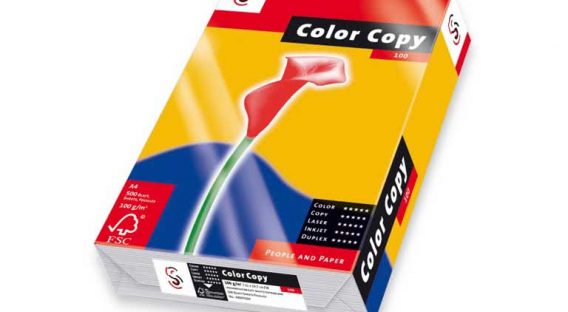
“The 100 g/m² Color Copy premium paper for thesis printing […] was specially developed to produce a particular brilliance and value.”
There are very cheap paper grades, the airy and rough quality of which can be seen with the naked eye. Touching the paper for the first time usually confirms this first impression. It just feels cheap, and it is even less fun to hold the paper in your hands longer, let alone deal with the written content. These are normally low-cost papers with a paper thickness of 80g/m².
It’s hardly surprising that the currently advertised printing prices are the lowest we’ve ever seen. But you get what you pay for, and this reflects the quality of the paper for thesis printing.
There are, however, paper types that exhibit a high quality thanks to their greater paper thickness and smooth surface. These papers include, for example, 100g/m² Color Copy premium paper for thesis printing. This paper has been specially developed to produce a particular brilliance and value. These factors play a special role, in particular in theses.
BachelorPrint has specifically addressed the requirements of students and graduates and thus only uses 100g/m² Color Copy paper for thesis printing. Together with leather binding, particularly with a premium suede cover, your bachelor’s thesis, master’s thesis, or doctoral thesis will stand head and shoulders above the rest!

Top Quality Thesis Printing
Using the highest quality paper for thesis printing is worthless if the printer’s performance is limited or inferior. Only with powerful brand printers, such as those produced by multi award winning manufacturer Xerox, is the highest print quality achieved, which you can’t only see, but also feel! To make sure that graduates are convinced of the paper quality before printing, they can, of course, come in and feel the 100g/m² Color Copy premium paper in their hands.
“Only with high performance brand printers […] can the highest print quality be achieved”
Only when you, the customer, are 100% convinced of the paper for thesis printing, the print quality and our service, have we done our job. And we’re looking forward to it!
After the printing of your bachelor’s thesis, Mmster’s thesis or dissertation, the right binding should also be chosen. We’ll give you the support you need to prepare your academic work through the experience and know-how we’ve acquired over many years. Just ask us. We wish you luck!
At BachelorPrint , the 100g/m² paper is the standard paper used for thesis printing. However, if you have a bachelor’s thesis, master’s thesis, PhD thesis or dissertation with a very high page count, we recommend you use the 120g/m² premium paper for thesis printing and have the paper printed on both sides. In doing so, you will save space and the page limit for leather binding is then not exceeded. Thanks to the thickness of the paper for thesis printing, you can’t see the text on the other side.
We use cookies on our website. Some of them are essential, while others help us to improve this website and your experience.
- External Media
Individual Privacy Preferences
Cookie Details Privacy Policy Imprint
Here you will find an overview of all cookies used. You can give your consent to whole categories or display further information and select certain cookies.
Accept all Save
Essential cookies enable basic functions and are necessary for the proper function of the website.
Show Cookie Information Hide Cookie Information
Statistics cookies collect information anonymously. This information helps us to understand how our visitors use our website.
Content from video platforms and social media platforms is blocked by default. If External Media cookies are accepted, access to those contents no longer requires manual consent.
Privacy Policy Imprint
- ALL ARTICLES
- How To Study Effectively
- Motivation & Stress
- Smarter Study Habits
- Memorise Faster
- Ace The Exam
- Write Better Essays
- Easiest AP Classes Ranked
- Outsmart Your Exams
- Outsmart Your Studies
- Recommended Reads
- For Your Students: Revision Workshops
- For Your Teaching Staff: Memory Science CPD
- Our Research: The Revision Census
- All Courses & Resources
- For School Students and Their Parents
- For University Students
- For Professionals Taking Exams
- Study Smarter Network
- Testimonials

Printing & binding a thesis: The ultimate how-to guide
by William Wadsworth | Feb 9, 2020
If I’m honest, I only ever had to bind a small handful of assignments for submission, so I never really gave it too much thought. But as I started talking to more different students in different positions, I realised there were actually some important decisions to make when it comes to binding major pieces of work like a thesis or dissertation. So I asked invited BachelorPrint , a popular printing company, to share their take on the options, and what’s going to work best for you. Enjoy ! William, Exam Study Expert Founder

You’ve finally made it:
All those hours in the library, all that time bashing away at your keyboard; your big paper is nearing completion. You’ve done your proofreading , and all that remains is to choose the right printing and binding for your thesis or dissertation.
There are three things to think about:
- What’s the best thesis binding option?
- What print settings should I choose?
- Where should I get it printed?
Let’s walk through each of these in turn.
What’s the best binding option for my thesis?
For a big project or thesis, you can’t just stick a staple in it and hope for the best. Your institution might have specific submission guidelines that dictate how your research paper should be bound, which you’d be well-advised to check.
There are four main binding options:
Each method of binding a thesis, dissertation or research paper is best for different reasons, as we’ll explain.
Overview of thesis binding options
Choosing the right option can be confusing, so we’ve put together a handy overview of binding options for your thesis or dissertation, showing you which type of project each is suitable for, how many pages the binding type can accept, what options you have for the cover, and how they compare on cost:
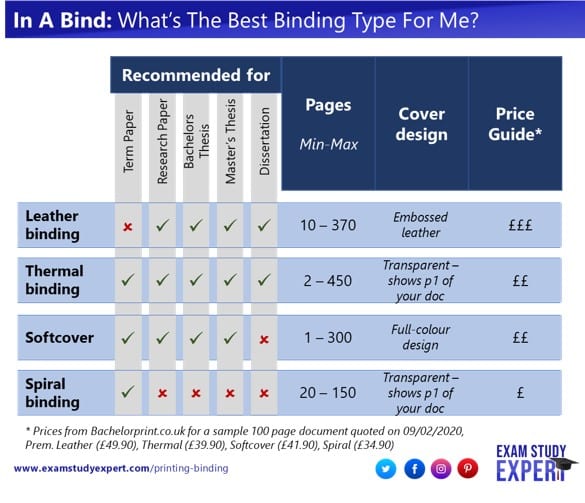
Leather binding: go classy
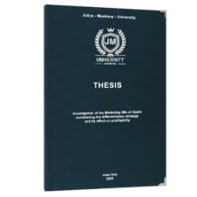
Leather binding is the highest quality binding option for your thesis : perfect for major final research papers such as dissertations, or your Bachelor’s or Master’s thesis. Some print shops will let you emboss the cover with your title and institutions logo, or add finishing touches such as a bookmark or corner protectors to make your submission really stand out.
Thermal binding: go versatile
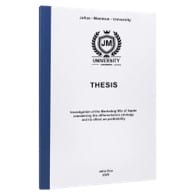
Thermal binding is the most versatile of all bindings . It’s perfect for smaller research projects, but can handle page counts of up to 450 pages too, more than any other bind type. It has a transparent front cover, which immediately brings the title of your thesis to the forefront. The back is often a leather-effect cover, for a quality finish.
Softcover binding: go creative
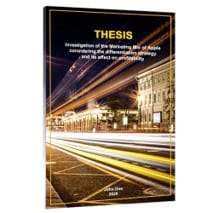
If you want your dissertation to stand out and look more creative , then we suggest going for a softcover binding. This gives you the option of designing the cover the way you want to. Different fonts, logos, pictures or totally wild designs – when you choose softcover, you can let your creative juices flow!
But go easy on the clipart and don’t let it get too cluttered – you still want to keep a professional-looking finish. In principle, you can use softcover binding for any type of final paper, but the page limit of 300 makes it less suitable for really big projects.
Spiral binding: go low-cost
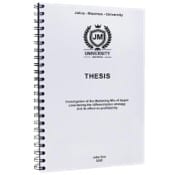
Spiral binding is the simplest and cheapest option , perfect for smaller research projects and term papers. There are two different types of spirals available – plastic and metal – with plastic spiral bind machines often being found in university / college libraries.
Spiral binding is less suitable for larger submissions such as dissertations and theses as page count is often restricted, and with plastic spiral binding in particular, the plastic binding can interfere with a smooth page turn, making for a less polished reading experience.
Free: Exam Success Cheat Sheet
My Top 6 Strategies To Study Smarter and Ace Your Exams
Privacy protected because life’s too short for spam. Unsubcribe anytime.
What print settings should I choose for my thesis?
Settled on a binding option for your thesis? Great. Now you just need to choose how the interior pages are going to appear.
There are four main things to think about here:
1. Black and white or colour
Printing in colour can be more expensive, but will definitely help your research paper to stand ou t, and may be particularly important in some fields like laboratory science or art history where colour is an essential component of your figures.
Be careful with to avoid gratuitous use of colour in your finished document – overdoing the colour can start to look a little cheesy!
2. Single or double-sided
Opting for double-sided keeps the finished document slimmer, (and is kinder on the planet!) though bear in mind it isn’t necessarily cheaper.
Examiners and assessors sometimes prefer single-sided so they can make notes on one side of the page, so check your institution’s submission guidelines – they often specify whether you must print on both sides of the paper or just one.
3. Paper thickness matters
Paper thickness is measured in “grams per square metre” – “gsm” or “g/m²”.
A higher gsm means a thicker paper and a more premium feel, but typically at a higher price.
Some print shops default to 80gsm. This can cause “bleed-through” when printing double-sided, which is where whatever is printed on the reverse of the page is visible from the front of the page, cheapening the overall feel of your submission.
You’ll see some improvement on bleed-through by upgrading to a thicker paper at 100gsm.
If you’re printing a major submission double-sided, especially if it’s got a lot of ink-heavy figures, you’d be best off opting for a premium 120 gsm paper.
4. Thesis printing and binding: delivery time!
Finally, make sure it arrives in time! At BachelorPrint, we offer free 24-hour express delivery as standard on all orders.
Where to go for thesis binding?
For morning-of-deadline printing and binding panics, you’re left with no alternative than to take your finished thesis, paper or dissertation to your local print shop. Most university towns will have one – though even a physical shop may have a limit on how quickly they can turn a document round, especially if it’s long and you need multiple copies.
So try and plan ahead if you can.
If you’re ready a day or more before the deadline, consider saving yourself some time (and money!), and getting access to a wider range of options through an online provider such as BachelorPrint.
At BachelorPrint , we offer:
- Free express shipping as standard: place your order by 9am (Mon-Thurs) for next-day delivery by 6pm the following day.
- A 3D preview of your binding and “look-inside” function, so you know exactly how the finished print is going to look.
- A wide range of print and bind options at student-budget-friendly prices!
Whatever options you choose for your binding and printing, and wherever you go to get the job done, we’d like to wish you all the best with your thesis!
The Science Of Studying Smart
Download my free exam success cheat sheet: all my #1 must-know strategies to supercharge your learning today.
Your privacy protected. No spam. Unsubscribe any time.
- Latest Posts
- Dr Haili Hughes – mentoring scholars & effective study skills teaching [PODCAST] - 1 May 2024
- Dunlosky’s Student Toolbox In Action – Amarbeer Singh Gill [PODCAST] - 29 Apr 2024
- [PODCAST] Understanding Memory – Peps McCrea - 24 Apr 2024
Submit a Comment Cancel reply
Your email address will not be published. Required fields are marked *
This site uses Akismet to reduce spam. Learn how your comment data is processed .
Read My Test-Taking Technique Book For More Marks In Exams

Top Picks: Recommended Reading From The Blog
How To Study Effectively : Ultimate Guide [READER FAVOURITE]
Exam Memorization Secrets
Inspirational Exam Quotes
Finding The Perfect Study Routine
Pomodoro Method : 9-Step Guide
Best Books About Studying
Listen To The Podcast


Community Blog
Keep up-to-date on postgraduate related issues with our quick reads written by students, postdocs, professors and industry leaders.
Thesis binding and printing options
- By DiscoverPhDs
- November 29, 2020

If you have recently completed your dissertation congratulations are in order! But the work is not finished – you now have to get your dissertation in front of examiners in a professional format. There are a number of factors to consider when producing a physical copy of your thesis :
- Type of binding (for example: helical or softback)
- Paper size (are some pages better suited for A3?)
- Print options (single or double-sided?)
- Paper quality (a range of gsm options are available)
What is Thesis/Dissertation Binding?
Thesis binding involves fastening the physical pages of your dissertation together to produce a single presentable document. As simple as it sounds, there is a lot to get right, and dissertation binding is important in giving a good impression of your work.
What are the different types of dissertation binding?
Spiral/helical/wired binding.
Spiral binding (also known as helical binding) and wired binding are very common for bachelors and masters dissertations. These options give a professional look and allow pages to be rotated 360 degrees, making for easy reading. Spiral binding uses a plastic coil, whilst wire binding uses a metal wire.
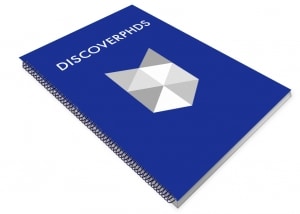
Fastback/softback binding
Fastback binding (also referred to as softback binding) uses glue to keep your dissertation pages together. This is not a very common choice for dissertation binding as it is rather formal for bachelors and masters, and perhaps not formal enough for PhD theses. Fastback binding also comes with a risk of glue losing fixity over time leading to pages falling out.

Thermal binding
Thermal binding is not very common but can be used for bachelors or masters dissertations. This type of binding is permanent (so pages cannot be easily added/removed) but is generally inexpensive. Another disadvantage of thermal bindings is that pages cannot be opened 360 degrees (as with fastback binding).

Plastic comb binding
Comb binding involves punching holes down the side of the page and binding with a plastic comb strip. This binding option is also suitable for bachelors and masters dissertations. It is a cheap option but can sometimes become difficult to navigate as pages become stuck on the plastic combing. One advantage of plastic comb binding is that it is easy to add and remove pages.

Paperback binding
Paperback binding will give your manuscript the appearance of a book and comes with personalisation options i.e. a titled cover page, spine and back. This gives a very professional appearance, too formal for a bachelors or masters dissertation, but ideal for a PhD thesis.
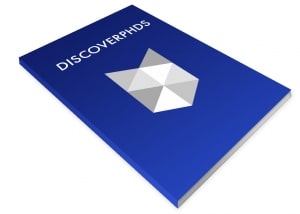
Hardback binding
Hardback binding again gives a book like appearance, but is expensive and typically reserved only for PhD theses. In addition to custom titling, spine and back, there is a range of material and colour options for hardback binding e.g. the gold lettering you may have seen on academic books.

What Paper Size Should I use?
Most universities will provide very clear instruction on paper sizes, most often A4. However, some pages such as technical drawings or maps may be best shown on A3. In these cases ‘fold out’ pages are an option but must be approved by your university guidelines.
Print Options:
Check your university guidelines when deciding whether to print single or double sided. If printing double sided, be careful as some pages should not be printed back to back. For example, new chapters should start on the right hand page (of a double spread) so blank pages may be required.
What Paper Quality is Suitable?
Paper thickness is measured in grams per square metre (gsm). Although there is no ideal paper thickness, too thin and you risk your dissertation feeling low quality. Too high and you risk your dissertation pages feeling like cardboard, and again pointing to low quality.
Popular UK Services:
Ryman is an affordable thesis binding service, with a range of options for dissertations and theses. Ryman often have stored on University campuses or nearby, so you can check the services provided by your local store (as an alternative to ordering online).
Doxdirect is an online service which offers a large amount of customisation when choosing a thesis binding option. The door to door service also offers a wide range of delivery and production options so you get your bound thesis in your hand as quick as possible.
Thesis Online has been around for a long time (established in 1920), and have a very good reputation. They offer an online thesis binding service and have a hand online calculator which allows you to modify your binding, printing, and deliver options and see the impact on cost in real-time.
Things to Note:
Whichever service you use to bind your thesis or dissertation, there are a few important things to remember:
When using an online service check the turnaround time. Most services take around a week to print, bind, and deliver, though faster services are available at a cost. Some universities have an onsite printing service that students can use. These services likely offer binding options which satisfy your department’s dissertation submission requirements.
An electronic copy and physical copy of your dissertation will be read differently. Whilst consecutive pages are easy to compare on a computer screen, a physical copy may have pages printed on opposite sides of a single page (if double page printed) which makes side by side comparisons difficult. This is something to consider if your text frequently refers to images or tables overleaf.
Most thesis printing services only accept PDF file formats. Ensure that when you convert your dissertation to PDF that you review the document to ensure no errors occur during conversion.
Check your university dissertation guidance on margin requirements. It is also important to factor in margins when considering binding options. Typically a minimum margin of 2.5cm is required on the side of the page to be bound.
Although it comes with an additional cost, it may be useful to purchase personal copies of your bound thesis. You can then bring your bound copy to your Viva , and ensure that what you and your examiners are looking at are identical.

Thinking about applying to a PhD? Then don’t miss out on these 4 tips on how to best prepare your application.

Being a new graduate teaching assistant can be a scary but rewarding undertaking – our 7 tips will help make your teaching journey as smooth as possible.
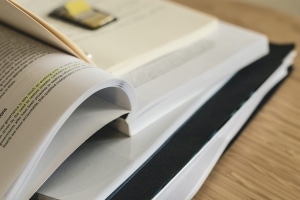
Find out the differences between a Literature Review and an Annotated Bibliography, whey they should be used and how to write them.
Join thousands of other students and stay up to date with the latest PhD programmes, funding opportunities and advice.

Browse PhDs Now

You’ve impressed the supervisor with your PhD application, now it’s time to ace your interview with these powerful body language tips.

Reference management software solutions offer a powerful way for you to track and manage your academic references. Read our blog post to learn more about what they are and how to use them.

Sabrina’s in the third year of her PhD at The University of Adelaide. Her esearch combines molecular techniques, data analysis, and next generation sequencing to investigate modifications on RNAs in plants.

Maria is a 1st year PhD student at the University of Birmingham, researching how to employ and exploit the biology of human gamma delta T cells for development of cancer immunotherapy.
Join Thousands of Students

- 1300 108 192

- Beer Coasters
- Booklets & Magazines
- Business Cards
- Rounded Business Cards
- Custom Calendar Printing
- Folded Brochures
- Greeting Cards
- Label Sheets
- Letterheads
- NCR Invoice Books
- Packaging / Boxes
- Laminated Postcards
- Presentation Folders
- Pull Up Banners
- With Compliments Slips
- Next Day Despatch
- Same Day Despatch
- View Shop / Order Online
- Print Ready Artwork
- Sample Packs
- Folding Diagrams
- Sending Large Files
- Lost password
- Address / Change Address
- Our Shipping Policy
- Our Refund Policy
- Custom Quotes
- Contact MVP Team

We are OPEN and TRADING over the Holiday Season
We are open australia day.
WE ARE OPEN & PRODUCING AT 100% THIS MONDAY 2nd OCT
Monday 2nd October (ACT, NSW & SA Public Holiday)

The King's Birthday Special
Order online this long weekend and get an extra, use the coupon code at the checkout, strictly for all business cards, bookmarks, flyers, folded brochures, swing tags and envelopes orders only. not available for any other product in our range or in conjunction with any other offer or coupon code currently available. for online orders only must be for the same artwork - no new templates or different artwork variations. no shady business - its not the royal way... ends monday 12th of june 2023 at 11.59pm, gsm in paper: a comprehensive guide for beginners.

- January 15, 2024
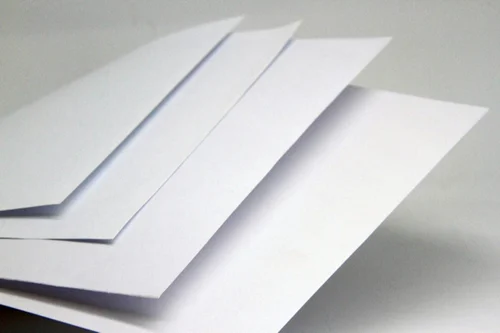
Welcome to our comprehensive guide on GSM in paper! If you’re new to the printing industry or simply interested in understanding how paper quality influences printed materials, you’ve come to the right place. GSM, or grams per square meter, is a crucial aspect of paper that plays a significant role in determining its weight, thickness, and overall quality.
In this guide, we’ll delve into the world of GSM in paper and explore its importance in the printing industry. We’ll explain how GSM is measured, its implications for paper weight and thickness, and the different types of GSM paper available. Additionally, we’ll discuss how GSM influences the perception of paper quality, the manufacturing process of paper, and crucial factors to consider when choosing the right paper weight for your project.
So, whether you’re a business looking to print brochures , flyers, or business cards, or an individual interested in understanding the science behind paper quality, this guide will provide you with valuable insights. Let’s dive in!
Key Takeaways:
- GSM, or grams per square metre, is a crucial aspect of paper that determines its weight and thickness.
- GSM is an essential factor to consider when selecting paper for printing materials.
- Different types of GSM paper are available to suit various printing needs in the industry.
- GSM influences the tactile feel, visual appeal, and environmental implications of printed materials .
- Choosing the right GSM depends on factors such as cost-effectiveness, durability, longevity, and frequency of use.
Understanding GSM in the Context of Paper Quality
When it comes to paper quality, understanding GSM (grams per square meter) is essential. GSM is a measure of the weight and thickness of paper and plays a crucial role in determining the overall quality of printed materials .
GSM measures the weight of paper in grams per square meter, indicating how dense and durable the paper is. Higher GSM values generally indicate thicker and more substantial paper, while lower GSM values indicate thinner and lighter paper.
The GSM of paper significantly impacts its suitability for different printing purposes. For example, higher GSM paper is commonly used for brochures, flyers, and business cards, as it offers a more professional and substantial feel, while lower GSM paper is ideal for lightweight printing needs like letterheads and envelopes.
By understanding GSM and its implications for paper quality, you can make informed decisions about selecting the right paper for your printing projects. The GSM paper guide provides a comprehensive resource for identifying the appropriate GSM range based on your specific requirements.
Choosing the right GSM (or paper thickness)for your printing needs ensures that your materials have the desired look, feel, and durability. Whether you’re printing promotional materials , business stationery, or marketing collateral, understanding GSM is crucial for achieving the best possible results.
Stay tuned for the next section to explore how GSM is measured and its role in determining paper weight and thickness.
GSM in Paper: Measuring Weight and Thickness
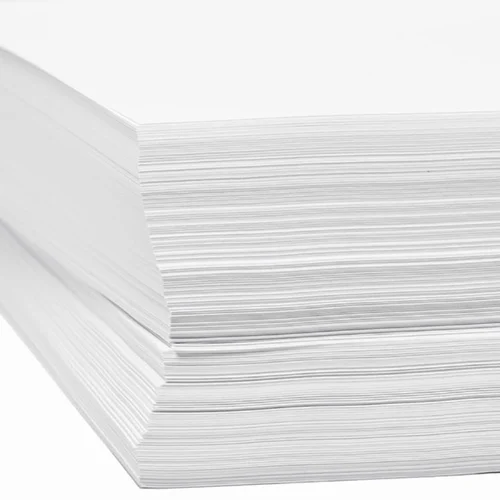
In the world of paper manufacturing, GSM plays a crucial role in determining the weight, thickness, density, and overall quality of paper. Understanding paper weight, or grams per square meter, is essential for selecting the right paper for various printing purposes.
What is GSM?
GSM is a measurement used to quantify the weight of paper per unit area. It refers to the weight of a single sheet of paper measuring one square meter. The higher the paper weight value, the heavier and thicker the paper will be.
The Importance of GSM to Paper Weight
GSM measurement is directly related to paper weight. It helps determine the sturdiness and durability of a paper product. For example, business cards and brochures typically use paper with a higher GSM to convey a sense of professionalism and durability. On the other hand, lightweight flyers and posters often utilize paper with lower paper weight for easier distribution.
GSM: A Measure of Density and Quality
In addition to measuring weight and thickness, GSM also provides an indication of paper density and quality. Higher GSM papers are denser and offer better print quality, while lower GSM papers may have a different texture and appearance. The GSM value serves as a standard for comparing the characteristics of different paper types , ensuring consistency in print results.
GSM Paper Types Across the Printing Industry
In the printing industry, various types of paper are available based on GSM (grams per square meter) measurements. Each GSM paper type possesses unique properties and characteristics that make it suitable for specific printing applications. Let’s explore some of the most commonly used GSM paper types and their uses:
- 80 GSM: This lightweight paper is commonly used for everyday printing needs such as documents , letters, and forms. Commonly used as household printer paper
- 100 GSM: A slightly thicker and more durable option, 100 GSM paper is often used for flyers, posters, and brochures .
- 120 GSM: This medium-weight paper is suitable for applications such as booklets , menus, and catalogues.
- 150 GSM: A heavier paper option, 150 GSM is commonly used for high-quality marketing materials like business cards and invitations.
- 200 GSM: This heavyweight paper is ideal for premium marketing collateral, including postcards brochure covers, , greeting cards, and luxury product packaging.
- 250 GSM and above: These ultra-thick paper options are commonly used for magazine covers, business cards with embossing or debossing effects, as well as specialty products like gift cards and certificates.
When selecting GSM paper for different printing projects, it’s crucial to consider the specific requirements and desired outcomes. The choice of GSM paper type can greatly affect the overall look, feel, and durability of the printed materials , ensuring they meet the desired quality standards.
The Significance of GSM for Various Printed Materials
Choosing the right GSM (grams per square meter) for your printed materials is crucial to ensure optimal quality and functionality. Different print materials have specific requirements, and selecting the appropriate GSM can make a significant impact on their effectiveness. Here are some important considerations for choosing the right GSM for business cards , brochures, flyers, posters, booklets, and menus.
Choosing GSM for Business Cards and Brochures
Business cards and brochures serve as essential marketing tools, representing your brand and leaving a lasting impression on potential clients. When selecting GSM for business cards , it’s important to strike the right balance between durability and professionalism. Opt for a higher GSM (around 300-350) to ensure that your business cards are thick and sturdy, conveying a sense of quality to recipients. Similarly, for brochures, a higher GSM (around 120-170) will provide a substantial feel and durability, enhancing the overall presentation.
Appropriate GSM for Flyers and Posters
Flyers and posters are often used to grab attention and convey information effectively. For these materials, a slightly lower GSM (around 80-100) paper stock is recommended. This lower GSM allows for easy distribution and ensures that the flyers and posters are lightweight while still maintaining a good level of durability. The choice of GSM in this range strikes a balance between cost-effectiveness and the visual impact of the printed materials.
GSM Considerations for Booklets and Menus
Booklets and menus require durable paper that can withstand frequent handling and potential spills. A higher GSM (around 150-200) is ideal for booklets, providing a substantial feel and ensuring that the pages remain intact over time. Similarly, menus benefit from a higher GSM (around 120-170) to withstand repeated handling and retain their professional appearance. By opting for a higher GSM, the booklets and menus will exude quality and longevity.
Choosing the appropriate GSM for your printed materials ensures that they not only look professional but also serve their intended purpose effectively. By considering the specific requirements of each print material, you can make informed decisions and create printed materials that make a lasting impact on your target audience.
GSM Paper Guide: From Thin to Thick
In the printing industry, it is essential to understand the different categories of paper weights. This guide will help you navigate from thin to thick paper options and their applications.
1. Thin Paper
Thin paper, also known as lightweight paper, has lower GSM measurements. It is commonly used for projects that require flexibility and a delicate touch. Examples include:
- Notepads and notebooks
- Letterheads and stationery
- High-volume printing, such as magazines and newspapers
2. Medium Paper
Medium paper falls in the middle range of GSM measurements. It offers a balance between flexibility and durability, making it suitable for various printing needs. Some applications of medium-weight paper include:
- Corporate brochures
- Flyers and leaflets
3. Thick Paper
Thick paper, also referred to as heavyweight paper, has higher GSM measurements. It offers a sturdier feel and is ideal for projects that require durability and a sense of premium quality. Here are some examples of where thick paper can be used:
- Business cards
- Invitations and greeting cards
- Event posters and banners
By understanding the different categories of GSM paper weights, you can choose the most suitable option for your printing projects. Whether you need thin, medium, or thick paper, selecting the right paper weight will contribute to the overall quality and impact of your printed materials.
How GSM Influences the Perception of Paper Quality
In the world of printing and design , the choice of paper plays a significant role in determining the overall quality of a printed material. One crucial factor that greatly influences this perception is the GSM (Grams per Square Meter) of the paper. GSM refers to the weight and thickness of the paper and has a profound impact on how the paper feels, looks, and even its environmental implications.
The Tactile Feel of Paper Weight Variations
The tactile feel of paper is an essential aspect of the overall user experience. Different paper weight variations offer distinct tactile sensations when touched. Lighter GSM papers, such as those around 60-70 GSM, tend to be thinner and more delicate, while heavier GSM papers, like those above 200 GSM, have a more substantial and sturdy feel. The choice of paper weight can influence the perception of paper quality through the tactile experience it provides.
Visual Appeal and GSM Selection
Visual appeal is another crucial aspect that determines the perceived quality of printed materials. Paper weight selection affects the appearance of the final product, as different paper weight levels can impact ink absorption, color vibrancy, and overall print clarity. Lighter papers may yield a more translucent and lightweight appearance, suitable for designs that require a subtle and elegant touch. On the other hand, heavier papers offer a more solid and robust look, making them ideal for projects that demand durability and a premium feel.
Environmental Implications of Different GSM Levels
When considering the environmental impact of paper, paper weight levels have a significant role to play. Higher GSM papers generally require more raw materials to produce due to their increased weight and thickness. This can have implications for deforestation and carbon emissions. Opting for lower GSM papers, which are lighter and require fewer resources, can contribute to a more sustainable approach to printing and design .
Comparison of GSM Variations and Their Effects
Gsm and the manufacturing process of paper.
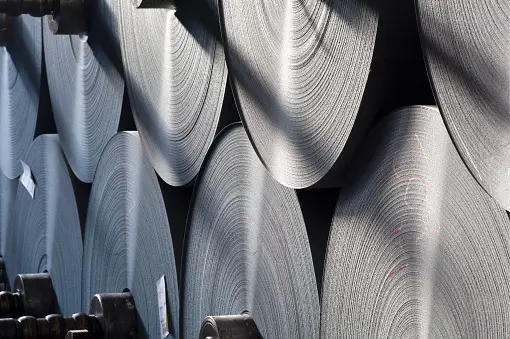
In the world of paper production, GSM plays a crucial role in ensuring consistent paper quality. Let’s take a closer look at how GSM is related to the manufacturing process of paper and how it is measured and maintained.
GSM, or grams per square metre, is a unit of measurement that quantifies the weight and thickness of paper. It is calculated by weighing a one-square-meter sheet of paper and determining its mass. This measurement helps determine the density and quality of the paper, which in turn impacts its suitability for different printing purposes.
During the paper manufacturing process, various factors come into play to achieve the desired paper weight. These include the selection of raw materials, such as wood pulp or recycled paper, and the use of additives like sizing agents and fillers. The manufacturing process involves pulping, refining, and forming the paper sheet, followed by drying and finishing.
Quality control measures are implemented throughout the manufacturing process to ensure the paper weight is maintained consistently. This includes regular GSM testing to monitor and adjust the paper’s weight and thickness. Additionally, paper mills employ various techniques to ensure uniformity and minimize variations in paper weight, such as refining the pulp and maintaining strict process controls.
By maintaining a consistent paper weight, paper manufacturers can guarantee that the paper they produce meets the required quality standards. This enables printers and end-users to have confidence in the paper’s performance and ensures optimal printing outcomes.
Through the meticulous manufacturing process and stringent quality control measures, paper manufacturers can ensure that the GSM of their products meets the required specifications. This, in turn, contributes to the overall quality and performance of the paper, making it suitable for a wide range of printing applications.
Choosing the Right GSM for Your Project
When it comes to selecting the appropriate GSM for your project, several factors should be taken into consideration. These factors can significantly influence the choice of GSM, ensuring cost-effectiveness, durability, longevity, and frequency of use.
Factors That Influence GSM Choice
Choosing the right GSM involves considering various factors that align with the specific requirements of your project. These factors include:
- Printed Material: Different types of printed materials may require varying levels of GSM to achieve the desired quality and durability.
- Target Audience and Perception: The target audience and their perception of paper quality play a crucial role in determining the appropriate GSM. A higher GSM may be preferred for materials intended to convey a sense of professionalism and luxury.
- Printing Technique: Certain printing techniques may require specific GSM to ensure optimal results. Consult with your printer to determine the suitable GSM for the chosen printing method .
- Budget: Cost-effectiveness is a vital consideration. Choosing a GSM that meets your budgetary constraints while still maintaining the desired quality is essential.
Cost-Effectiveness vs. Durability
When selecting the right GSM, you must assess the balance between cost-effectiveness and durability. A higher paper weight generally implies a thicker and more substantial paper, which can contribute to its durability. However, it is essential to evaluate whether the additional durability is necessary for your specific project, as a higher GSM can also increase the overall cost.
Longevity and Frequency of Use
Consider the longevity and frequency of use when choosing the GSM for your project. If the printed materials will be subjected to frequent handling or environmental factors, opting for a higher GSM can ensure increased durability and longevity. On the other hand, if the materials have a shorter lifespan or will only be used occasionally, a lower GSM may suffice.
Common GSM Paper Sizes for Printing Needs
In the printing industry, it is important to choose the right paper size for your projects. The commonly used GSM paper sizes vary depending on the printing needs and requirements. Here are some of the standard paper dimensions and their applications:
These are just a few examples of the common GSM paper sizes used in the printing industry. Choosing the appropriate paper size based on your specific printing needs ensures that your printed materials are visually appealing and well-suited for their intended purpose.
GSM: The Backbone of Professional Printing
In the world of professional printing , GSM (Grams per Square Meter) is a crucial factor that determines the quality and performance of printed materials. Professionals pay meticulous attention to GSM because it plays a vital role in delivering exceptional printing results that meet the highest standards.
Why Professionals Pay Attention to GSM
The importance of GSM in professional printing cannot be overstated. By carefully selecting the appropriate GSM for each printing project, professionals can ensure that the final product meets the desired specifications and delivers a lasting impression.
GSM affects various aspects of printed materials, including their weight, thickness, and overall durability. Professionals understand that the right GSM can enhance the tactile feel of printed materials, convey a sense of quality, and make a lasting visual impact on the audience.
Standardizing GSM for Consistency in Printing
To maintain consistency in printing, standardization of paper weight is essential. By following standardized paper weight guidelines, professionals can ensure that every printing job meets the required quality standards and meets customer expectations.
Standardizing paper weight involves selecting predefined GSM ranges for specific purposes, such as business cards , brochures, flyers, posters, booklets, and menus. This helps maintain consistency in the texture, weight, and overall feel of the printed materials across different projects.
MVP Print’s Approach to GSM Selection

At MVP Print , we prioritize GSM selection to deliver outstanding professional printing results. Our approach involves in-depth consultation with our clients to understand their specific requirements and objectives.
We use our expertise and industry knowledge to recommend the most suitable paper weight for each project, taking into consideration factors such as the intended use of the printed materials, desired durability, and desired visual appeal.
By carefully selecting the optimal paper weight, MVP Print ensures that every printed piece captures the essence of our clients’ brand and delivers the highest level of professionalism and quality.
In conclusion, understanding GSM in paper is crucial for achieving optimal printing outcomes. Throughout this comprehensive guide , we have explored the concept of paper weight and its significance in the printing industry. GSM measures the weight, thickness, density, and quality of paper, making it a vital factor in selecting the right paper for various printed materials.
By choosing the appropriate GSM for business cards , brochures, flyers, posters, booklets, and menus, you can ensure that the paper matches the intended purpose and creates the desired impact. Additionally, considering factors such as cost-effectiveness, durability, longevity, and frequency of use helps in making informed decisions while selecting the right GSM.
The tactile feel and visual appeal of different variations play a significant role in shaping the perception of paper quality. Furthermore, standardizing GSM across the printing industry ensures consistency in print results. Whether you’re a professional printer or an individual seeking printing services , understanding paper weight and its implications is essential for achieving high-quality printing outcomes.
By staying informed about paper weight and its role in manufacturing processes, you can confidently select the right GSM paper for your projects. Remember, GSM is not just a number—it’s the backbone of professional printing. So, pay attention to paper weight and make informed decisions for your printing needs.
What does GSM in paper mean?
GSM stands for grams per square meter and is a unit of measure for the weight and thickness of paper. It is used to determine the overall quality and density of the paper.
How does GSM measure paper weight and thickness?
GSM measures the weight of paper by determining the weight of one square meter of the paper. The higher the GSM value, the heavier and thicker the paper.
Why is GSM important in the printing industry?
GSM is important in the printing industry because it helps determine the suitability of paper for different printing purposes. It affects the print quality, durability, and overall appearance of the printed materials.
What are the different types of GSM paper?
There are various types of GSM paper available, ranging from lightweight to heavyweight. Each type has different properties and characteristics suitable for specific printing needs.
What GSM should I choose for business cards, brochures, flyers, posters, booklets, and menus?
For business cards and brochures, it is recommended to use a higher GSM paper for a more professional and durable finish. Flyers and posters can be printed on a medium GSM paper, while booklets and menus can use a lighter GSM paper for easier handling.
What are the different categories of paper weights based on GSM?
Paper weights based on GSM can be categorized into thin, medium, and thick paper. Thin paper has a lower GSM value, while thick paper has a higher GSM value.
How does GSM influence the perception of paper quality?
GSM influences the perception of paper quality by affecting the tactile feel and visual appeal of the paper. Higher GSM paper feels more substantial and is perceived as higher quality. Additionally, different paper weight levels can have environmental implications.
How is GSM related to the manufacturing process of paper?
GSM is related to the manufacturing process of paper as it is measured and maintained during production to ensure consistent paper quality. It is a crucial factor in determining the overall density and thickness of the paper.
What factors should I consider when choosing the right GSM for my project?
Factors to consider when choosing the right paper weight include cost-effectiveness, durability requirements, and the longevity and frequency of use for the printed materials.
What are the common GSM paper sizes used in printing?
Common GSM paper sizes include A4, A3, Letter, and Legal. These sizes are widely used for various printing needs and are available in different paper weight options.
Why do professionals pay attention to GSM in professional printing?
Professionals pay attention to paper weight in professional printing because it helps ensure consistent print quality and standardization. GSM selection is an important aspect of maintaining high-quality printing outcomes.

- 1`Blog (193)
- Beer Coasters (32)
- Book Printing (18)
- Booklets (39)
- Bookmarks (8)
- Business Cards (35)
- Calendars (12)
- Cheap Printing (2)
- Colour Theory (10)
- Design (30)
- Eco Friendly (2)
- Envelopes (4)
- Flyers (11)
- Folded Brochures (14)
- Gift Vouchers (1)
- Golf Cards (1)
- Greeting Cards (1)
- Leaflets (4)
- Letterheads (4)
- Logo Design (6)
- Magazines (15)
- Melbourne Printing (7)
- MVP Print (2)
- NCR Books (1)
- Networking (23)
- Newsletters (5)
- Pad Printing (3)
- Postcards (5)
- Posters (9)
- Print Marketing (89)
- Printing (98)
- Promoting (43)
- Saddle Stitched Books (14)
- Same Day Dispatch (5)
- Small Business (17)
- Stationery (1)
- Stickers (1)
- Swing Tags (2)
- Uncategorized (44)
- With Comp Slips (1)
- February 2024
- January 2024
- December 2023
- November 2023
- October 2023
- September 2023
- August 2023
- February 2021
- January 2021
- December 2020
- October 2020
- September 2020
- August 2020
- February 2020
- January 2020
- October 2019

- [email protected]
- Melbourne | Sydney | Adelaide | Brisbane | Perth | Hobart | Darwin
HELPFUL LINKS
- Request a Sample Pack
- Privacy Policy
NEWS & DISCOUNTS
© All rights reserved | MVP Print
Custom Flyer Quote
Fill out the details below and one of our Quoters will get back to you within a few hours.
WELCOME TO MVP PRINT
Use the codeword 'mvp' to get 5% off your first order, sign up and make your first order today.
The Codeword ‘MVP’ is a one time only coupon code that you can use on any Product featured on our website. Terms & Conditions Apply.
Leaving So Soon?
Would you like a, 10% discount, enter your email & receive your discount code.
Discounts are for selected products only; these include Business Cards, Flyers, Folded Brochures, Postcards, Greeting Cards, Stickers, Presentation Folders. Does not include Same Day or Next Day Products. One Coupon per Customer / Order.
Quill And Fox
Best Design Studio

Amber Robertson
Amber Robertson is the founder of Quill and Fox. A creative writing studio that helps people find their voice and share their stories. Amber is also a published author, with her first book slated for release in 2020. She loves spending time with her family and friends, reading, writing, and traveling. When Amber was younger, she loved to write short stories and plays. But somewhere along the way, she lost touch with her creativity. It wasn’t until she became a mom that she realized how important it was to share her stories—both the good and the bad—with the people she loves most. That’s when Quill and Fox was born. Amber is passionate about helping others find their voice and share their stories. She believes that every person has a story worth telling, and it’s her mission to help them tell it in a way that is authentic and true to themselves
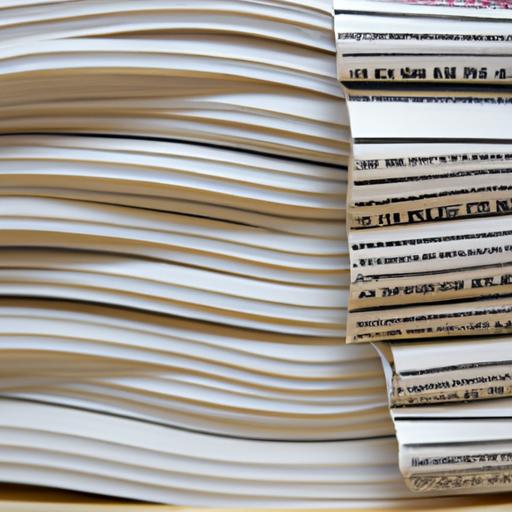

What Does GSM Mean in Paper? An In-Depth Explanation
Table of Contents
Introduction

If you’ve ever bought paper products, you may have noticed the letters “GSM” on the packaging. But what exactly does GSM mean, and why is it important to understand? In this article, we’ll explore the definition of GSM, its measurement, and why it matters in the paper industry.
Definition of GSM
GSM stands for “grams per square meter,” which is a measure of paper’s weight and density. It refers to the weight of one square meter of paper, expressed in grams. For example, a sheet of paper that measures 21 x 29.7 centimeters and weighs 80 grams per square meter has a GSM of 80.
GSM is determined by weighing a specific amount of paper and measuring its surface area. The higher the GSM, the thicker and heavier the paper, while lower GSM indicates thinner and lighter paper. This measurement is used in the paper industry to classify and compare different types of paper products.
There are different types of paper products available in the market, and each has its unique GSM value. For instance, printer paper usually has a GSM between 60 and 120, while cardboard has a higher GSM of 400 or more. Understanding the GSM of paper is essential for choosing the right paper product for a specific purpose.
Types of GSM Paper
Paper products come in various GSM values, depending on the purpose of the paper. The different GSM values of paper products are used to classify and compare various paper types. Here are some examples of paper products with different GSM values:
High GSM Paper
High GSM paper is thicker and more substantial, making it durable and long-lasting. It is used for printing business cards, greeting cards, postcards, and wedding invitations. High GSM paper is ideal for printing materials that require a premium and professional look and feel. It is available in GSM values of 200 to 300, making it significantly heavier than standard printer paper.
Medium GSM Paper
Medium GSM paper is commonly used for printing flyers, brochures, and newsletters. It is thinner than high GSM paper, making it more flexible and easier to fold. It has a GSM value of 100 to 170, which is suitable for printing materials that require a balance between substance and flexibility.
Low GSM Paper
Low GSM paper is the most common type of paper used for printing documents. It is lightweight, making it easy to handle, and it has a GSM value of 60 to 90. Low GSM paper is ideal for printing documents such as letters, memos, and reports, where flexibility and convenience are essential.
Understanding the different types of GSM paper is crucial in selecting the right paper product for a specific purpose. By choosing the right GSM of paper, you can ensure that your printed material looks professional and high-quality.
Importance of GSM in Printing
GSM plays a crucial role in determining the quality of printed materials. The GSM of paper affects the thickness, texture, and durability of the paper, which, in turn, affects the print quality. Here are some ways in which GSM affects printing quality:
Ink Absorption
The GSM of paper determines how much ink it can absorb. High GSM paper can absorb more ink, resulting in a better quality print with sharper and more vivid colors. On the other hand, low GSM paper may not absorb ink evenly, resulting in a faded or blurry print.
Print Resolution
The GSM of paper also affects the print resolution, which is the level of detail that can be printed on the paper. High GSM paper allows for a higher print resolution, resulting in a more detailed and accurate print. Low GSM paper, on the other hand, may not be able to handle a high print resolution, resulting in a lower quality print.
The GSM of paper determines the paper’s durability, which is essential for printed materials that require a longer lifespan. High GSM paper is more durable and long-lasting, making it ideal for printing materials such as business cards and brochures that need to withstand wear and tear.
Best GSM for Various Printing Needs
Choosing the right GSM for printing materials is crucial for achieving the desired print quality. Here are some recommended GSM values for various printing needs:
Business Cards
For business cards, a GSM of at least 300 is recommended to ensure durability and a premium look and feel.
Brochures and Flyers
For brochures and flyers, a GSM of at least 150 is recommended for a good balance between substance and flexibility.
Letters and Reports
For letters and reports, a GSM of 80 to 100 is recommended for flexibility and convenience.
By choosing the right GSM for your printing needs, you can ensure that your printed materials look professional and high-quality.
GSM and Paper Weight
GSM and paper weight are often used interchangeably, but they refer to different aspects of paper. Paper weight refers to how heavy a ream of paper is, while GSM refers to the weight of one square meter of paper. The relationship between GSM and paper weight is direct, meaning the higher the GSM, the heavier the paper weight.
The weight of paper affects its quality, texture, and durability. The higher the weight, the more robust and long-lasting the paper is. Heavyweight paper is ideal for printing materials that require durability, such as business cards, postcards, and invitations.
On the other hand, lightweight paper is more flexible and easier to handle, making it suitable for printing documents such as letters, memos, and reports. Lightweight paper is also cheaper and more accessible to produce, making it the most commonly used paper for printing.
Understanding the relationship between GSM and paper weight is essential in choosing the right type of paper for a specific purpose. By selecting the appropriate paper weight and GSM, you can ensure that your printed material looks professional and high-quality.
In conclusion, understanding GSM in the paper industry is critical in selecting the right paper product for a specific purpose. GSM is a measure of paper’s weight and density, and it is determined by the weight of one square meter of paper. It is used to classify and compare different types of paper products, and each type of paper has its unique GSM value.
By understanding the different types of GSM paper and their values, you can choose the right paper product for a specific purpose. The weight of paper also affects its quality, texture, and durability, making it essential to consider when selecting a paper product.
In summary, GSM is an essential aspect of the paper industry, and it is crucial to understand its meaning, measurement, and application. By considering the GSM and paper weight, you can ensure that your printed material looks professional, high-quality, and fit for its intended purpose.

What is GSM Paper – The Ultimate Guide [Reviewed 2023]
Share with whom you care:.
An average office employee uses at least 10,000 sheets of paper per year. That comes down to at least 28 sheets of paper per day.
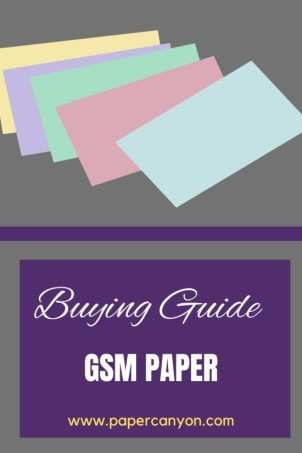
And we haven’t even included the average use of paper by schools and other such institutions.
But have you ever wondered what in fact is the point of creation of these staggering amounts of paper? Or what are the specifications one needs to know while purchasing paper?
Well, to scratch the surface, paper is circulated globally by the essence of its weight, and is called GSM paper. Well not essence in particular, but you get the gist of it.
On the other hand , if you are still a tad bit confused about it, or need to know more about how the entire concept of GSM paper works then get your reading glasses on because we are about to discuss some heavyweight paper, pun intended.
Let’s begin at the beginning.
What in fact is a GSM paper?
It would not be wrong to say that GSM could be a quantified term. GSM is an acronym for ‘grams per square meter’. To simplify it for you, the standardization of various types of paper in terms of weight is done through a sample sheet that is one square meter in size.
Check 100’s of Free Printables for Kids
After this sample sheet has been procured, it is used as an ideal for all sorts of other purposes. It is important to note that this sample remains consistent, doesn’t matter the length or breadth of the paper. Let us explain this to you with the help of an example.
Let’s say a sheet of paper weighs 200 gsm. This means that every square meter of that entire sheet – be it A4 or A5 – weighs 200 gsm irrespective of its size.’
Moreover, different weights in GSM represent different textures of paper. For example, a paper with a weight of 40 gsm would be much thinner and lighter than a paper that weighs 350 gsm. The 350 gsm paper, on the other hand, would be thicker and durable and has its own designated purposes.
A Note to Remember:
A paper that weighs 40 gsm will not weigh the same when cut down to poster size or letter size. Either way, both the types will be considered 40 gsm paper as ‘gsm’ represents a quantified thickness or thinness.
Let’s Get Virtual
If you still find it difficult to conceptualize this paper world, then we have it planned one step ahead of you. Here is a YouTube video explaining all that you need to know about GSM paper in less than a minute.
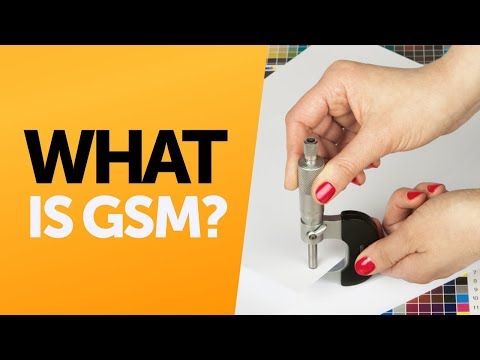
Synopsis: In this video, you will be briefed upon what GSM paper is and why it is important. Moreover, you will learn about various GSM paper related weight measurements, and which sort of paper is compatible for various works such as sketching, printing , promotion and more.
Should you really care about the weight of the paper that much?
Well to sum up, yes. The weight of the paper that one uses is crucial to the sort of work being done. It is important enough to have a term after it. GSM of a paper decides what it should be used for, and is referred to as the paper’s ‘grammage’.
That is not the only reason you should take the weight of your paper seriously. There are various other reasons, and to name a few:
- Different types, different styles
It is common knowledge that different types of paper are used for different purposes. You would not want your party invitation to be made out of the same paper as a notepad, would you? We’re not saying you can’t, but elegance does come as a cost.
- Avoid ink related faux-pas
If you are using a paper that weighs 90 gsm or below, then there is a high probability of the ink bleeding through the paper, rupturing your designs or work. To avoid putting yourself in a faux-pas, it is recommended that you use the GSM paper based on the type of work you have to do.
- Suit Up Your Business!
In any sort of business related endeavor, it is important to showcase your dedication through a materialistic lifestyle. In a way, what you own also defines you in a business. Naturally, you would like a stiff and sturdy business card rather than a flappy and easily bendable one. So, suiting up your paper is also important.
Now, GSM paper is used for almost all the purposes one could use paper for. To further help you understand it, here is a summary of the standard weight of the paper and what it is used for:
- 35 gsm – 55 gsm : The thinnest kind of paper available, this type of GSM paper is translucent and primarily used for tracing or for newsprints.
- 75 gsm – 90 gsm : This type of GSM paper is ideally used for sketch pads or notepads, as it is suitable for some light paperwork or sketching. If one were to use ink on it, there is a hundred percent chance it will bleed through.
- 90 gsm – 100 gsm : This type of GSM paper is your everyday printer paper, commonly found in most households.
- 120 gsm – 140 gsm : Think promotional paper! This type of GSM paper is commonly used as movie posters or is also used for displaying various products at stores for promotional purposes.
- 210 gsm – 300 gsm : This type of GSM paper is comparatively stiffer yet bendable. One might come across this paper on some magazines and high quality flyers. In fact, most bases for watercolor or painting papers are made from this GSM paper.
- 350 gsm – 450 gsm : This type of GSM paper is the stiffest and sturdiest out of all the papers, and is like cardstock. One may have encountered these types of papers on business cards or invitations.
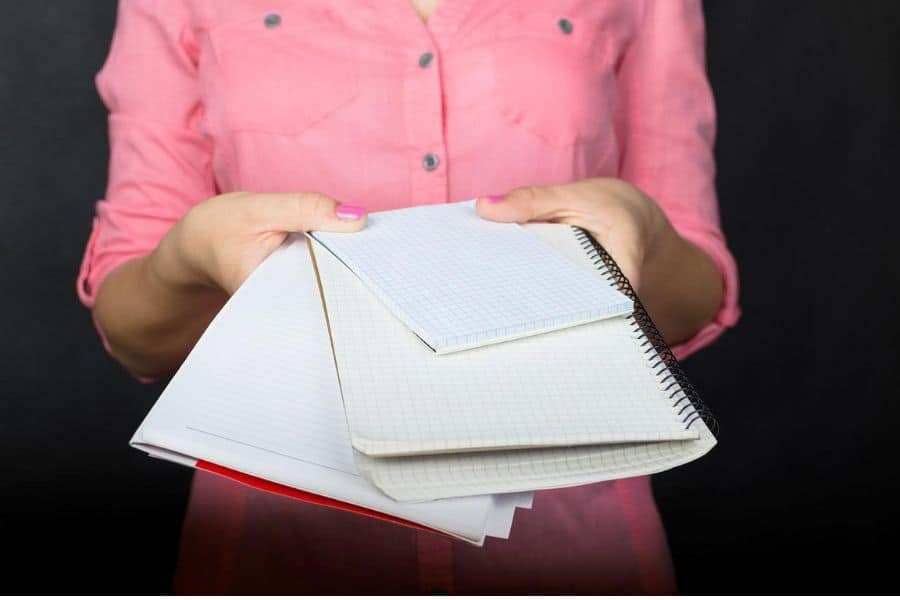
Measurements – How do GSM paper measurements work?
Naturally, there are different measurements used for different textures and styles of papers. It primarily depends on the sort of work one needs to do, and there are standard sizes for everything. For example, the standard size of a business card will differ from the standard size of a letter, or a brochure for that matter.
So if you are a paper geek or here on a confidential work related sojourn… either way you will glimpse into the limits of a limitless world of paper.
Here is a list of the most globally accepted set of standard sizes when it comes to GSM paper:
ISO A Paper – Measurements and Sizes
The internationally accepted standard for GSM paper is ISO A. It uses millimeters and meters for measurement purposes. The largest format in this type of GSM paper is A0, which is one square meter in size.
The next step of measurement is taken by cutting down the initial size of GSM paper into half along the widest dimension. For example, the next size that comes after A0 is A1. Thus, A1 is dictated by cutting A0 in half.
Here is a list of the most accepted sizes from a range of A0 which is the largest size, to A10 which is the smallest size.
- A2 – 420 x 594 mm (or 16.54 x 23.39 inches) This size of GSM paper is used in maps, smaller posters or even diagrams.
- A4 – 210 x 297 mm (or 8.27 x 11.69 inches) This size of GSM paper is used in magazines, catalogs, letters and documents.
- A6 – 105 x 148 mm, or 4.13 x 5.83 in This size of GSM paper is used in postcards. It is also a common print size for photographic pictures.
ISO B Paper – Measurements and Sizes
Another common type of sizing schedule used for measuring GSM paper is ISO B. This standard of measurement is primarily used for poster sizing.
Similar to A0 size of paper, the B0 size is also the largest succeedingly going down to B10 which is the smallest measurement of GSM paper of this standard.
Here is a list of the commonly and globally accepted sizes from ISO B:
- B4 – 250 x 353 mm (or 9.84 x 13.90 inches)
- B2 – 500 x 707 mm (or 19.69 x 27.83 inches)
- B0 – 1000 x 1414 mm (or 39.37 x 55.67 inches)
ISO C Paper – Measurements and Sizes
ISO C is another globally accepted standard of GSM paper measurement. However, here the only difference is that it is applicable to the sizes of envelopes that fit and correspond to the varied sizes of ISO A Paper.
Here is a list of the commonly and globally accepted sizes from ISO C:
- C6 – 162 x 114 mm (or 6.38 x 4.49 inches)
- C4 – 324 x 229 mm (or 12.76 x 9.02 inches)
- C2 – 648 x 458 mm (or 25.51 x 18.03 inches)
Graphic designing is a paradigm widely associated with paper, more often than not GSM paper. It is necessary to have a clash of the vibrant colors together to create something genuinely unique. How to differentiate one GSM paper from another and how to consume its optimal usage is something that you will learn in this YouTube tutorial.

Synopsis: In this YouTube video, you will learn about what GSM stands for, and how it has been a constant proponent of creativity in the world of graphic designing.
Here, the YouTuber also interests you in a book, or a guide of GSM paper neatly stacked up with different sizes of the paper and then glued together. So, if you are really really really interested in papers and graphic designing and can muster up the patience to sit through this comparatively longer video, then off you go young padawan. May the force be with you.
If you love drawing/painting, check Drawing Supplies page.
What does GSM stand for?
GSM in ‘GSM Paper’ stands for grams per square meter.
What can I use GSM paper for?
GSM paper is basically all sorts of paper that you use. It could be defined as a unit of measurement. It is used to differentiate between various textures of paper depending on their thickness.
What is the thinnest and thickest size of GSM paper?
The thinnest size of GSM paper ranges from 35 gsm to 55 gsm. This type of paper is mostly used for tracing and news printing. On the other hand, the sturdiest type of paper measures 350 gsm to 450 gsm and is primarily used for invitations and business cards.
Can I use 35 gsm paper for sketching or painting?
The 35 gsm paper is the thinnest GSM paper by the measures of weight, and it is not recommended to use it for sketching or painting. This is because it is comparatively less durable, thinner and easily bendable which would make it difficult to sketch on the paper. Furthermore, the ink from color pastels or oil pastels might seep through the paper, thus draining it and rupturing the art.
Which GSM paper is best for drawing?
It is recommended that you use GSM paper weighing between 90 gsm to 100 gsm if you would like to draw. This is because the weight of GSM paper is a combination of enough sturdiness and rigidity that is required for drawing on paper.
Which GSM paper is best for printing photographs?
If you would like to get a photograph printed, then it is recommended that you use GSM paper ranging between 210 gsm to 300 gsm. This type of paper is stiff yet bendable, and you can get a glossy texture on the finalized print.
What paper should I use for everyday household printer related work?
Well, you can easily rely on GSM paper for going about your household printer related work. The standardized GSM size for this type of work ranges between 90 gsm to 100 gsm. This type of paper would not let the ink seep through, and is highly flexible, which makes it suitable for being used as a printer paper.
Paper covers a varied portion of the substrata of industrialization. It can be used in schools for arts and craft related purposes and in legal corporations for reporting highly confidential information. In between this spectrum lie multiple other ways to creatively use paper in everyday life.
Thus, it is important to categorize the type of paper one needs to use depending on the feasibility and accountability of the sort of project one needs to do. The GSM paper is varied in its durability, reliability and effect, so tread lightly.
You can visit Wikipedia to know more about papers.
You can reach out to us in case you have any queries . We will for sure try to reply to your concerns as soon as possible.

Avni Deopura
Content Writer
An SEO Expert, a Prolific Content Writer, and a dreamer currently pursuing a postgraduate degree in Master of Science in Psychology from St. Joseph’s College of Arts and Science. She is working as a Content Producer and Social Media Analyst .
End of ― “What is GSM Paper – The Ultimate Guide”
How useful was this post?
Click on a star to rate it!
Average rating 5 / 5. Vote count: 2
No votes so far! Be the first to rate this post.
We are sorry that this post was not useful for you!
Let us improve this post!
Tell us how we can improve this post?

Similar Posts
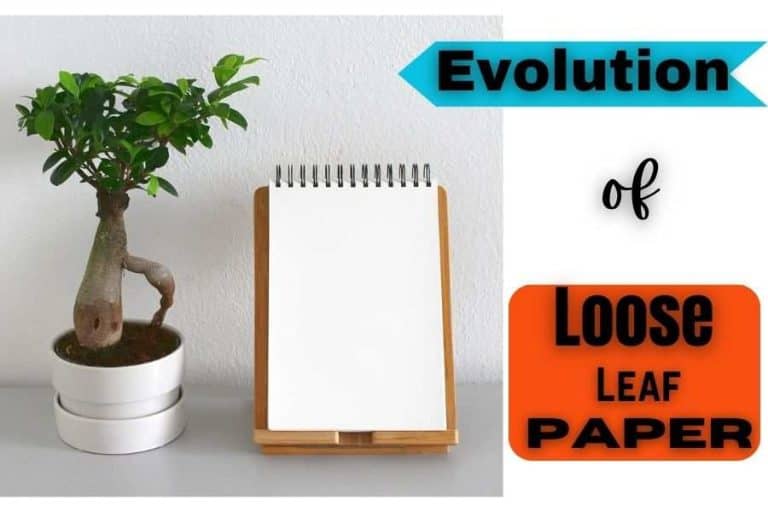
The Evolution of Loose Leaf Paper: From Paper Pads to Personalized Pages
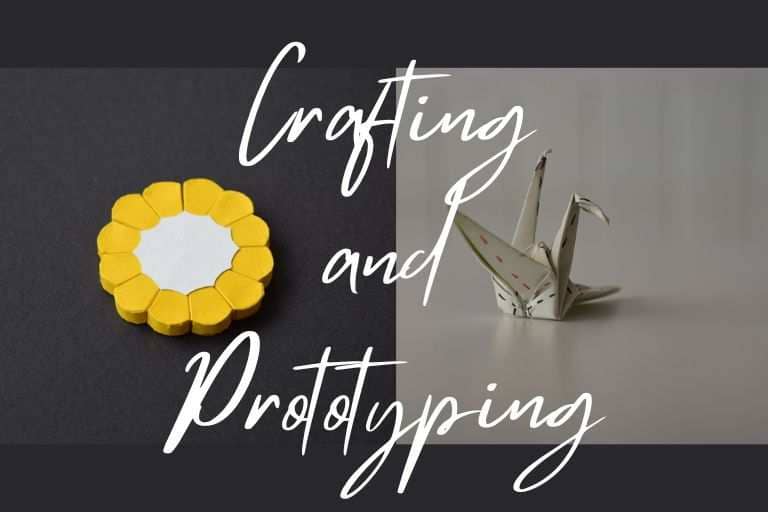
The Ultimate Guide to Crafting and Prototyping with Paper
![thesis paper gsm Best Types of Paper for Sleek ‘n’ Chic Crafting [Updated 2023]](https://mlapnvimd7ak.i.optimole.com/w:768/h:512/q:mauto/f:best/https://papercanyon.com/storage/2022/08/Paper-for-Crafting-Easy-Guide-768x512.jpg)
Best Types of Paper for Sleek ‘n’ Chic Crafting [Updated 2023]
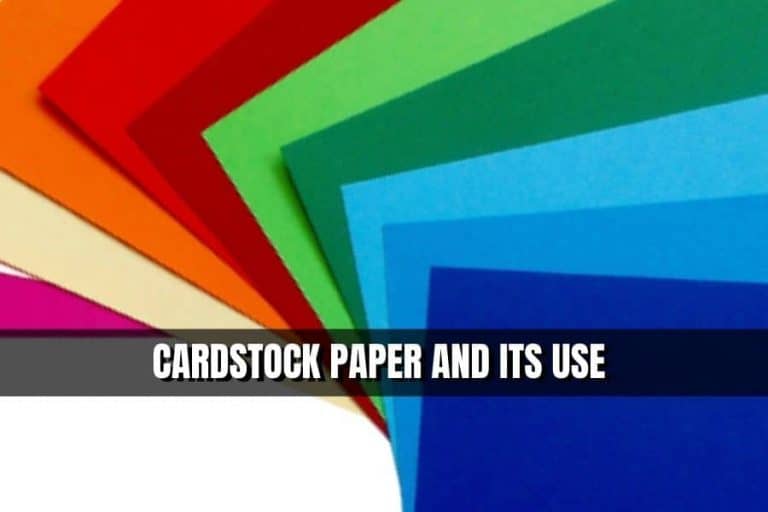
Everything You Need to Know about Cardstock Paper | The Ultimate Buying Guide
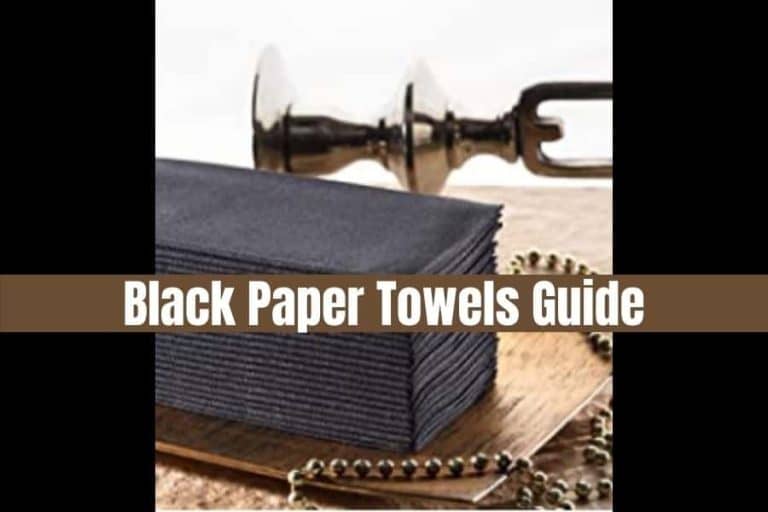
Black Paper Towels: The Ultimate Buyer’s Guide
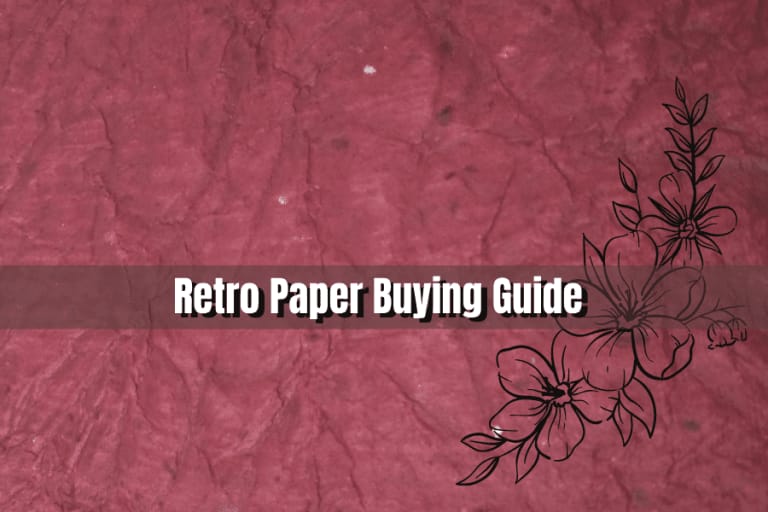
Retro Papers – All That You Need to Know

Southworth 100% Cotton Thesis Paper, 8.5” x 11”, 20 lb/75 GSM, Wove... › Customer reviews
Customer reviews.

Southworth 100% Cotton Thesis Paper, 8.5” x 11”, 20 lb/75 GSM, Wove Finish, White, 250 Sheets - Packaging May Vary (35-120-10)
Customer Reviews, including Product Star Ratings help customers to learn more about the product and decide whether it is the right product for them.
To calculate the overall star rating and percentage breakdown by star, we don’t use a simple average. Instead, our system considers things like how recent a review is and if the reviewer bought the item on Amazon. It also analyzed reviews to verify trustworthiness.
Top positive review
Top critical review
There was a problem filtering reviews right now. Please try again later.
From the united states, there was a problem loading comments right now. please try again later..
- ← Previous page
- Next page →
Questions? Get fast answers from reviewers
- Amazon Newsletter
- About Amazon
- Accessibility
- Sustainability
- Press Center
- Investor Relations
- Amazon Devices
- Amazon Science
- Sell on Amazon
- Sell apps on Amazon
- Supply to Amazon
- Protect & Build Your Brand
- Become an Affiliate
- Become a Delivery Driver
- Start a Package Delivery Business
- Advertise Your Products
- Self-Publish with Us
- Become an Amazon Hub Partner
- › See More Ways to Make Money
- Amazon Visa
- Amazon Store Card
- Amazon Secured Card
- Amazon Business Card
- Shop with Points
- Credit Card Marketplace
- Reload Your Balance
- Amazon Currency Converter
- Your Account
- Your Orders
- Shipping Rates & Policies
- Amazon Prime
- Returns & Replacements
- Manage Your Content and Devices
- Recalls and Product Safety Alerts
- Conditions of Use
- Privacy Notice
- Consumer Health Data Privacy Disclosure
- Your Ads Privacy Choices
Free Delivery Across Ireland on all Orders | 100% Secure Online Ordering | 4 Step design check before printing
Email: [email protected]
- Quick Quotation
Username or email address *
Password *
Lost your password? Remember me
Or login with

- Business Cards
- Personalised Invoice Books
- Coloured Invoice Books
- Custom Receipt Books
- Headed Paper / Letterhead Printing
- Compliment Slip Printing
- Desktop Roller Banners
- A6 Leaflet Printing
- A5 Leaflet Printing
- A4 Leaflet Printing
- A4 Brochures Printing
- A3 Brochures
- A4 Stapled Booklet Printing
- A5 Stapled Booklet Printing
- Standard Pull-up banner
- Double Sided Pull-up Banner
- Desktop Roller Banner
Complete GSM Paper Guide: What is GSM Paper and How do you choose?

- November 20, 2023
If you’ve ever printed your own business cards, flyers, or other marketing materials, you might have observed that the stocks—or the paper—are identified by a term known as “GSM.” What is a GSM paper, is a question that might have come to your mind.
Selecting the appropriate GSM paper for your printed products is crucial, so to help you get started we’ve put together this brief beginner’s guide to GSM paper and a guide to paper weight.
What is a GSM Paper?
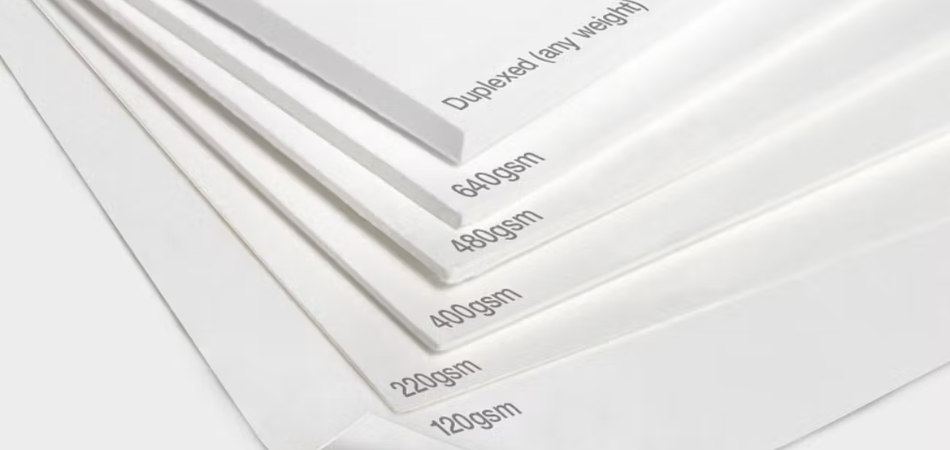
“Grams per square metre” (GSM) is a unit of measurement used to describe paper weight. In general, the better the perceived quality of the stock, the heavier the paper and the higher the grams per square meter.
This is sometimes referred to as the “grammage” of the paper.
A 150gsm flyer, for instance, is thin and bends or folds easily, whereas a 250gsm flyer is much heavier and requires more work to fold.
A square meter of the paper is weighed after it has been cut to size to get this measurement. It will certainly weigh less when trimmed to the proper size (A5 for an A5 flyer), but as GSM is measured per square meter, it will still have the same GSM.
GSM paper Guide: Why are there various GSMs?
In short, distinct items are compatible with different GSMs. For instance, a greeting card must have a thicker material than a poster since it must stand alone when shown, whereas a poster is typically framed or affixed to a wall.
Letterheads are yet another excellent example. When a client receives letterhead paper , it should feel substantial and premium yet still be thin enough to print the letter on a typical office printer.
Restaurant menus are printed on thicker stocks since they are more likely to be used again, but bulk flyers for posting through letterboxes or takeout menus are for one time use and typically produced on a mass level. So to make it more economical, they are printed on thinner stocks.
Thicker stocks feel more impressive, while thinner stocks typically imply a lower quality. Because of this, our premium business card line is offered on 400gsm silk paper, which is significantly thicker and of higher quality than the 350gsm cards that the majority of printers offer.
How to choose the correct GSM paper?

Going for the lowest GSM could save you some money, but choosing the right GSM paper for your business depends on its purpose. You should make sure to weigh all of your options before making a decision.
This is due to the extended lifespan of a heavier GSM. For instance, if the main purpose of the flyers is to advertise an event that is happening tonight, a 120gsm A5 flyer would be the most economical option. But if your flyer is to be included in an exhibition goodie bag, you’ll want your flyer to hold up as it gets distributed throughout the workplace. A 350gsm might be preferable in this situation.
What are various GSM paper weights?
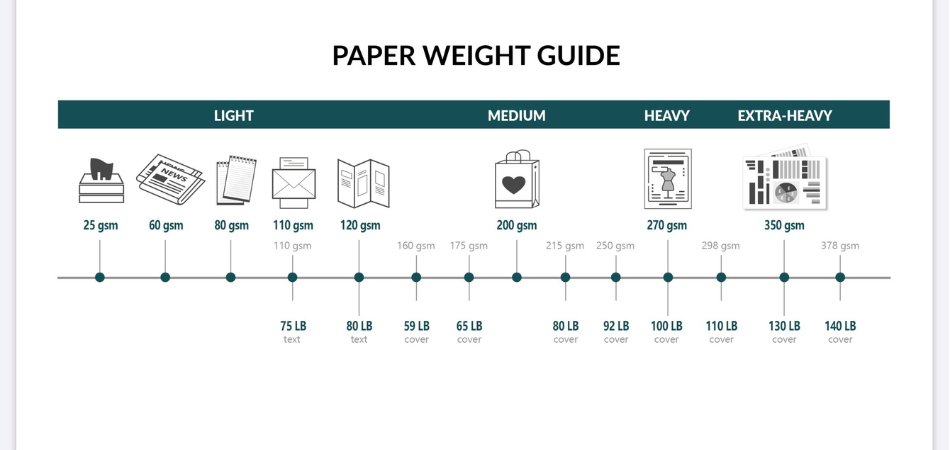
Here is a list of all the paper weights that are available when printing online with discoverprint , along with an explanation of their potential uses.
- 70-90gsm – This is a thin paper that is usually used for a notebook’s lined inner pages.
- 90-100gsm – The majority of printers in homes and offices use this paper weight.
- 120-150gsm – This weight of paper is used for printing movie posters, most thin flyers and takeout menus.
- 200-300gsm – Even though it’s stiffer, this weight can still bend. It’s widely used for more upscale flyers and menus, as well as magazine covers.
- 350-450gsm – This is a thicker, more pliable stock that resembles cards. It is utilized for a variety of print products, including table talkers, postcards, business cards, and greeting cards.
Still not sure which GSM Paper is best for your product? Don’t worry! Here on our blog, you can find a comprehensive list of all the different paper stocks we offer for each print item we sell, along with comparison images.
Never forget that our helpful customer support team is available to assist you if you’re still unsure or need guidance on a particular product!
Also Read: Ultimate Guide on Flyer Size
Other Useful Guides

How can personalised invoice books enhance brand identity?

What is Sequential Numbering? – Easy to understand Guide

What is NCR Printing – Facts & History about NCR Paper

Why choosing Personalised invoice books can be wise decision for small businesses

Complete Guide: Paper Printing

Print Ideas for this New Year
Browse our top print categories.

Envelopes Printing (1)

NCR Printing (3)

Business Cards (4)

Folded Brochures (3)

Business Stationery (2)

Flyers Printing (4)

Pull up Banner (3)

Sticker Printing (4)

DiscoverPrint - Your Local Print Partner
We are Discoverprint, an Irish design & print management company. We provide high quality yet low cost business and promotional printing to the Irish market.
Office: Discoverprint, The Cresent, NorthWood, Santry, Dublin.
Email: [email protected]
Open: Monday -Friday ( 9:0am – 5:30pm )
Top Sellers
Invoice Books
Stitched Booklets
Letterheads
A4 Brochures
Pull up Banner
Print Categories
Folded Brochures
Stapled Booklets
Stickers & Labels
Postcard Printing
NCR Printing
Useful Links
Medical Accountants
Accountants Dublin
Personalised invoice books UK
Gutter cleaning Dublin

Email: [email protected] EN^
Copyright © 2023. All Rights Reserved.
Home Website Privacy Policy Cookies Policy Delivery Information
- Login / Register
Get a Quotation Now
Share your printing requirement and we will be happy to share a quote.
Free 2nd Day Shipping on orders above $50.

- Create Account
- HP 12a Toner
- HP 42x Toner
- HP 83a Toner
- Brother LC103 Ink
- Brother LC203 Ink
- Brother LC3019XXL Ink
- Brother TN660 Toner
- Brother TN221 Toner
- Brother TN431 Toner
- Canon CLI-42 Ink
- Canon 245 246 Ink
- canon 240xl and 241xl combo pack
- Canon 104 Toner
- Canon 116 Toner
- Canon 128 Toner
- Epson 127 Ink
- Epson 786xl Ink
- Epson 200xl
- Epson 220xl Ink
- Epson 410xl Ink
- Epson 288xl Ink
- Kodak 30 Ink
- Konica Minolta
- Kyocera Mita
Everything You Need To Know About Paper GSM And How It Affects Your Printing
Knowing the right paper GSM for your printing requirements is crucial to ensure that you get the best results and avoid unexpected printing issues. If you are in the advertising industry, the paper you use can help create a good first impression to your customers before they even start reading the messaging.
For business owners who are confused about what GSM paper is, you’ve come to the right place! This guide will discuss the meaning of GSM and why paper thickness is crucial in the overall quality of your prints. We will also include a paper weight chart along with the recommended paper weights for different applications.

What is GSM?
Why is gsm so important, does paper gsm affect the quality of your prints, guide to gsm and thickness of paper, common paper gsm & recommended uses, what is the simplest way to measure paper weight, common gsm paper sizes you can choose from.
Let us start by defining what GSM is.
GSM, also known as grammage, stands for ‘Grams per Square Meter’ . It is used to measure the weight or heaviness of paper products and should not be disregarded when choosing papers regardless of your application.
This is the simplest way to understand what GSM is: the higher the GSM of a paper is, the thicker and heavier it will be. For instance, a 350gsm paper will be thicker and heavier compared to an 80gsm paper.
Typical office papers (which are thin and very flimsy) used in printers or copiers usually have 70-90 gsm paper weights. Newspapers use approximately 50 GSM. Business cards, book covers, and folders use around 200 gsm while event invitations use 300gsm papers.
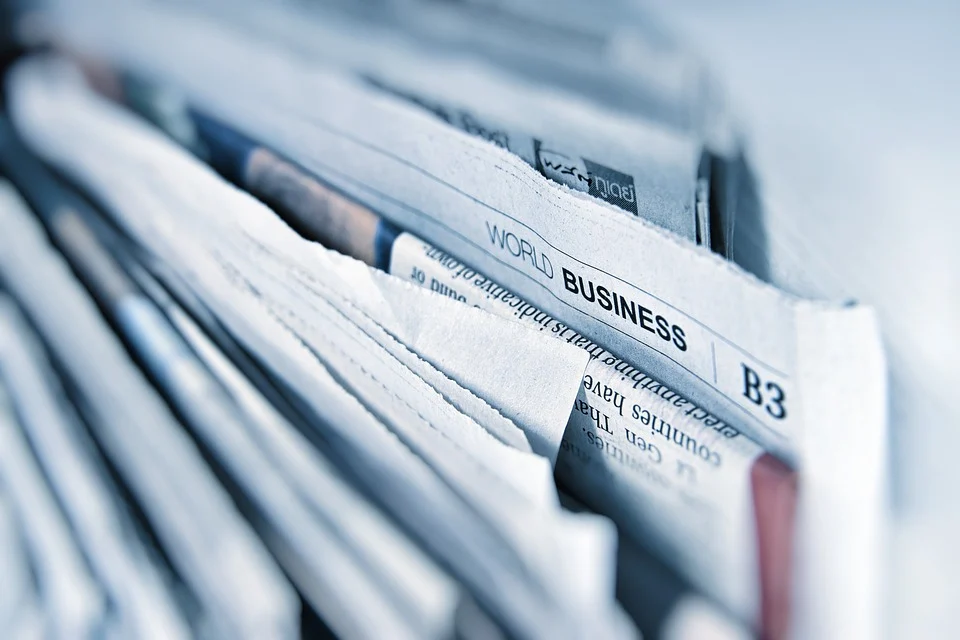
Since GSM is the most popularly used unit to measure paper weight, it’s important that you have a good understanding of what it is and how it is used.
1. GSM Affects How Your Customers Perceive Your Business
Whether you are into printing custom packaging materials, business cards, flyers, and others, the paper GSM you choose will have a huge impact on how your customers will see your business. Paper GSM has a big role in the overall and feel of your print materials.
There are a lot of paper weights you can choose from and each has its unique qualities to help ensure that your products stand out. Paper GSM also allows you to give the right message to your customers. Using paper with a higher GSM, like 300 GSM papers, gives an impression that your business is legitimate and professional.
If you want to show that you provide excellent products and great service, choose a paper GSM that best reflects your company. Use the right papers for your promotional materials to convey quality.
2. There are Paper Weights That Are More Suitable For Specific Applications
Although thicker paper provides a stronger statement, this doesn’t mean that you should always choose them for printing your materials. There are cases where thin papers are more appropriate, cost-efficient, and functional to use than thick papers. Let us take promotional flyers as an example.
Promotional flyers are usually produced in bulk and distributed nationwide. You can use a 300-gsm paper to ensure the production of long-lasting and professional promotions. However, it will be very inconvenient to carry a lot of heavy flyers around and your customers will have a hard time storing them. In these cases, lower-gsm papers are more suitable.
3. GSM Affects Your Printing Processes
Not all printers can handle all paper GSM, so make sure that your printer can handle the paper GSM you want to use. For in-house printing, small printers and copiers will likely support only a few paper GSM.
Moreover, GSM is important when running a paper on the press because it affects everything such as the imposition, ink types, and drying times. If your machine does not support the paper thickness you are using, the printer will have a difficult time processing the papers. The printer can even destroy the paper if you use too light ones.
You see, choosing the wrong paper GSM can be costly, especially if you are running a small business. That is how important GSM is.
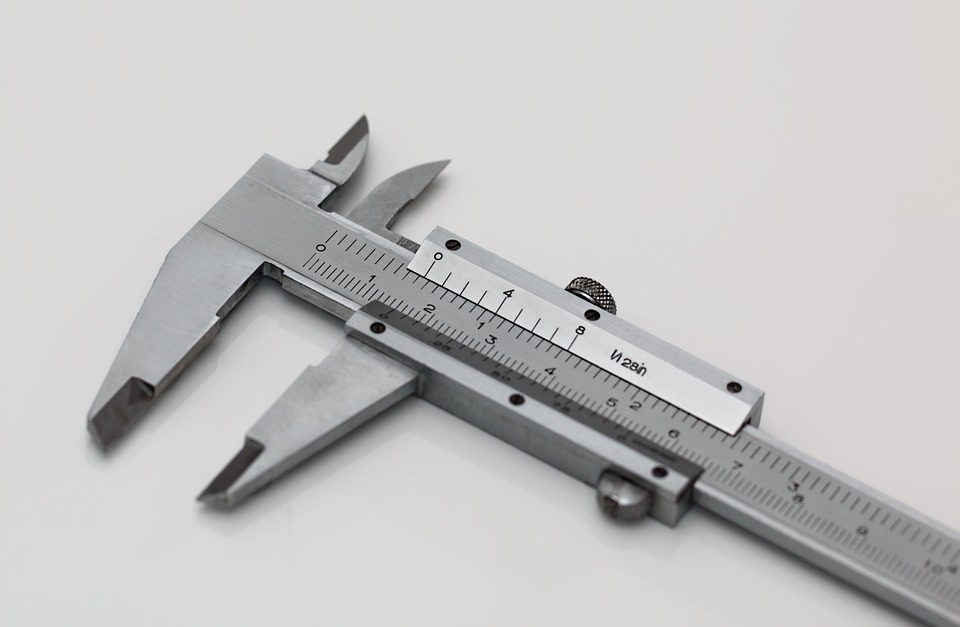
For sure, you have often heard people saying that the higher the GSM, the better. However, let us tell you that this is NOT necessarily true. GSM is not used to measure quality. It is only used to measure paper weight and nothing more.
Take note, though, that the GSM you should choose will highly depend on your application while the paper’s finish will greatly affect the design. Again, there are paper weights that are more suitable for photocopying or office printing. You should not use the same GSM for printing marketing materials like booklets and posters if you want to achieve the best quality.
Paper weight has a huge impact on the overall look and feel of your print materials as well as the buying decisions of your customers. They help make a statement. For instance, you want your business cards to be professional, vibrant, impactful, and sturdy. Thus, you should use paper with a higher GSM to achieve this goal.
Lastly, the quality of the papers from different brands may vary even if they have the same GSM. So make sure to get out there and explore your options to make sure that you get the most out of your money.
For a better understanding of the differences between GSM papers, you can refer to the table below:
Paper Weight
Description.
- This is the lightest paper type that ranges from translucent papers to newsprints
- These papers are common in notebooks and sketch pads.
- They are lightweight and easy to carry
- They are thick enough for drawing with a pencil. However, marker or heavy ink can bleed through.
- 90 GSM papers are the most budget-friendly options for creating high-quality prints for businesses
- Most household printer papers are of these types.
- They often come in 500 sheets per pack
120-140 GSM
- You see these on average promotional posters such as product posters in stores and movie posters as well as on low-cost flyers.
- They are common on pub walls and are sturdy enough to withstand wear and tear.
- You can easily fold them without crushing them completely.
160-180 GSM
- These are ideal for creating print products for official events where you need something that should not be folded but is still lightweight.
- 160gsm paper connects the gap between paper and board. It’s a thicker option for extra durability for printing quality flyers and brochure stocks.
200-300 GSM
- These reusable thick papers are sturdy and although not that hard, they offer a heavier finish.
- They are stiffer but you can still bend them.
- They are long-lasting papers that are not easily wrinkled or folded
300-400 GSM
- These are the stiffest and sturdiest papers that are used or invitations and business cards.
- These are good options for those who are looking for a superior finish.
Take note that although most suppliers only offer up to 400gsm papers, there are still thicker and heavier papers like 600gsm papers. Papers with a thickness of 600 GSM or more are commonly used by artists for watercolors.
Now that you know the differences between GSM papers, let us give you an idea of how thick these papers are. We’ve listed the thicknesses of a few common paper GSMs below.
Let us start with uncoated papers (laser, offset, or bond papers).
Uncoated Paper GSM & Thickness
Paper weight (gsm), thickness (mic).
Thin document paper
Standard copy paper
Standard Letterhead paper
Premium Letterhead paper
Heavyweight paper
Medium Board
Standard Board
Thick board
Thick business cardboard
For coated papers (matte, silk, or gloss), refer to the table below:
Coated Paper GSM & Thickness
Very thin magazine paper
Thin catalog paper
Thin brochure paper
Standard leaflet paper
Premium leaflet/brochure paper
Heavyweight leaflet paper
Thick Board
Do note, though, that the above values may vary depending on the brand of the paper. However, you can still use the information we provided as a guide when choosing the most suitable paper GSM for your printing needs.
To make sure that you choose the correct paper weight, you need to consider your application. Below is a short guide that can help you determine the most suitable paper GSM for your business:
Recommended Applications
- For everyday office copying and printing applications
- Cost-effective mass production of products such as booklets and flyers
100-120 GSM
- Printing stationery like compliment slip and letterheads
130-170 GSM
- Ideal for brochure pages, leaflets, flyers, and posters
- 135 GSM paper is the common option for printing budget-friendly promotional campaigns in events like conventions and tradeshows because it is less prone to wrinkling
- 170 GSM papers are widely used for printing professional-looking promotional materials for official events like shareholder meetings and business conferences
- Ideal for printing brochure covers, premium flyers, and banners
- They are also used for painting or watercolors
- Not suitable for printing mail campaigns because the weight of the paper will impact delivery costs
- Retail and hospitality industries commonly use 250 GSM and 300 GSM papers for printing paperback covers for booklets
- These heavy-weight boards are perfect for printing high-quality wedding stationery, presentations folders, leaflets, postcards, and business cards
Aside from GSM, the easiest method you can do to measure paper weight is to use a micrometer or a caliper. Through this method, you can measure the actual thickness of paper in increments of one-thousandth of an inch. You can also express this thickness in points. For instance, a paper that is 0.005 inches thick can also be called 5-point paper.
You can read more on how to use a caliper and how to read a micrometer through the provided links.
- How To Read A Vernier Caliper
- How To Read A Micrometer Screw Gauge
In addition to paper GSM, you need to choose the right paper size for your application. Below are the common paper sizes used in the printing industry:
ISO A Paper Series
ISO A is the international standard when it comes to paper sizing. A0 is the largest ISO A paper format which has a size of one square meter. The previous paper size is cut in half to achieve the succeeding smaller size.
For instance, A0 is cut in half to get the next smaller size which is A1. While A0 is the largest under this category, A10 is the smallest. Below are the standard sizes popularly used in printing:
ISO A Paper
Common uses.
16.54” x 23.39” or
420 mm x 594 mm
Used for diagrams, maps, and smaller posters.
8.27” x 11.69” or
210 mm x 297 mm
Used for documents, magazines, letters, and catalogs.
105 mm x 148 mm
Commonly used for photos and postcards.
You can find the complete list of ISO A series paper sizes here.
ISO B Paper Series
The ISO B standard is mainly used for sizing posters. Similar to the ISO A paper series, ISO B paper series also run from B0 to B10. Below are some sample ISO B papers starting with the largest one – B0:
ISO B Paper
39.37” x 55.67” or 1000 mm x 1414 mm
19.69” x 27.83” or 500 mm x 707 mm
9.84” x 13.90” or 250 mm x 353 mm
ISO C Paper Series
The last most common global standard for sizing paper is ISO C. This paper sizing standard is used for envelopes. You can find the most popular ISO C papers below:
ISO C Paper
25.51” x 18.03” or 648 mm x 458 mm
12.76” x 9.02” or 324 mm x 229 mm
6.38” x 4.49” or 162 mm x 114 mm
Read the complete ISO C series envelope sizes here.
Buying the right GSM for your printing needs is important to ensure the easy creation of well-designed printouts to impress your customers as well as boost your sales. There are many paper GSM you can choose from, but make sure that you pick the most appropriate one for your application.
Again, note that paper GSM is not directly related to print quality. It is more on what you are going to use it for because some paper weights are more suitable for certain applications. Hopefully, this guide was able to help you better understand what GSM is.
By the way, if you are looking for high-quality compatible and remanufactured ink and toner cartridges for your printing needs, feel free to check out YoyoInk ’s products!
Leave a Reply Cancel reply
Your email address will not be published. Required fields are marked *
The survey of GSM wireless communication system
Ieee account.
- Change Username/Password
- Update Address
Purchase Details
- Payment Options
- Order History
- View Purchased Documents
Profile Information
- Communications Preferences
- Profession and Education
- Technical Interests
- US & Canada: +1 800 678 4333
- Worldwide: +1 732 981 0060
- Contact & Support
- About IEEE Xplore
- Accessibility
- Terms of Use
- Nondiscrimination Policy
- Privacy & Opting Out of Cookies
A not-for-profit organization, IEEE is the world's largest technical professional organization dedicated to advancing technology for the benefit of humanity. © Copyright 2024 IEEE - All rights reserved. Use of this web site signifies your agreement to the terms and conditions.
- Same Day Printing in London | Open 7 Days a Week

- Appointment Cards
- Accessories
- Acrylic Prints
- Booklets - Comb Bound
- Business Cards
- Booklets - Wire Bound
- Booklets - Staple Bound
- Booklets - Perfect Bound
- Coasters Printing
- Covid PVC Banner Barrier
- Canvas Printing
- Correspondence Cards
- Cushion Covers
- Caps & Hats
- Crystal Blocks
- Compliment Slips
- Correx Boards
- Car Vinyl Wrap
- Cafe Banner Barrier
- Document Printing
- Drawstring Bags
- Dissertation Binding - Hard Cover
- Fleece Jacket
- Floor Stickers
- Flyers & Leaflets - Folded
- Foamex Boards
- Foam Boards
- Flyers - Laminated
- Hi-Vis Workwear
- Invitation Cards
- Invitation Cards- Folded
- Kids T-Shirts
- Loyalty Cards
- Letterheads
- Mesh Banner
- Magnetic Vehicle Signs
- Phone Cases
- Photo Panel
- Presentation Folders
- Pavement Signs
- Polos Shirts
- PVC Banners
- Roll Up Banner
- Round Sticker & Label
- Sweatshirts
- Selfie Frames
- Scented Candles
- Teddy Bears
- Vinyl Wall Stickers
- Water Bottles
- Wall Clocks
- Wall Papers
- Window Stickers
- dissertation bindings
150 Page Foil Printed Hard Cover 80gsm 120 or 170gsm bond paper
Dissertation bindings customization, customize your print product.
- 80 gsm Bond
- 120gsm Bond
- 170gsm Bond
- Single Sided
- Double Sided
- A4 (210X297 mm ) Portrait
- Plain Cover
- Foil Printed
- Premium Service (1-2 Working Days)
- Standard Service (3-5 Working Days)
- Saver Service (6-7 working days)
- Description
- Delivery & Return
Whether it's a thesis paper, research project or journal, it demands an outstanding quality binding that will represent the value of the content. Print Britannia recognizes the hard work of students; hence we are providing journal and thesis binding services at the most competitive rate.
Dissertation binding
Any academic work must have a professional-looking cover. Considering this matter, we are offering hardcover binding for dissertations, thesis, books or any research projects that require binding. The hardcover not only makes the booklet sturdy and reader-friendly but also brings an elegant and professional appearance. Below you can learn more about our available binding formats.
A4 Plain Hard Cover Binding
The most preferred binding style is plain hardcover binding. For plain cover binding, you can choose the paper type from 80gsm and 120 gsm bond paper. Then, you can also print on the spine, which will represent the title when you put it on the bookshelf. The best aspect of plain binding is that it's affordable and complements any thesis work.
Foil Printed A4 Hard Cover Dissertations Binding Printing
If you want a little more luxurious appearance on the dissertation cover, then you can choose the foil printed option. For this, we will provide the highest quality 170 gsm bond paper. Moreover, the available cover colour for you to choose from is black and blue. However, you cannot print on the spine for foil printed hard cover binding.
So, if you want to place an order for a bound dissertation right now, then send us the file in A4 portrait format. The file must be in the single-page format as well. And the booklet must contain a minimum of 50 pages and a maximum of 500 pages. If there is any additional specification you want on the cover, send us your requirements via email. We will meet all your expectations.
As you place an order, you can get the delivery within 2 days in our premium delivery service. Otherwise, you can get your complete bound dissertation within 5 days in our standard service. For any queries or discussions, feel free to write to us!
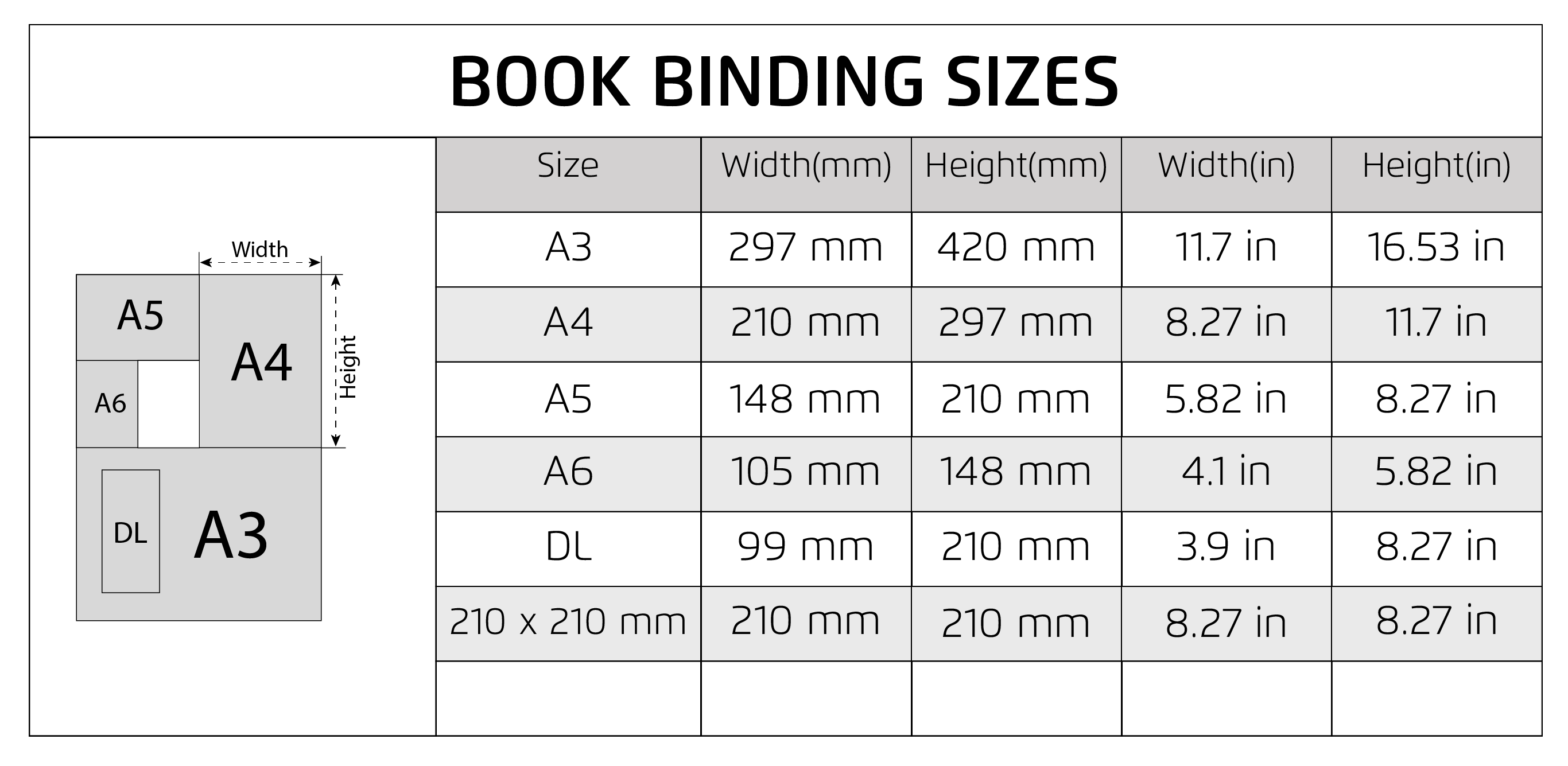
UK Delivery
It’s free for all UK mainland deliveries order over £30 (Net).
You can also order selected products before 2 pm and they will be with you very next day (only on selected London post code)
Once you have selected your products and before proceeded to checkout you will now have the choice of our week days Premium (1-2 working days), Standard (3-5 working days) and saver (5-7 working days) delivery options.
With Click & Collect at Print Britannia, you can now place your order online or offline and then pick up your products at your own time.
Claims in respect of damages in delivery, delay, shortage of quantity or impaired quality must be made in writing to us within 3 days of delivery.
We reserve the right to reprint defective work and shall not be liable to refund.
Our refund process can take upto 3 working days to complete once we have agreed to refund.
OFFER PRICE
Price Net £65.00
Your Discount (0%) £0.00
Vat (20%) £13.00
TOTAL PRICE £78.00
Estimated delivery time.
Premium Service 04.05.2024
Standard Service 07.05.2024
Saver Service 09.05.2024
Similar Products
Foil printed a4 hard cover dissertation binding, foil printed hard cover 80gsm 70 page, foil printed hard cover 80gsm 80 page, stay in touch.
Stay up to date with our newsletter!
The latest fashion & technology news
POPULAR PRODUCTS
- BUSINESS CARD
- STAPLED BROCHURE
- COMPANY HISTORY
- CURRENT VACANCIES
- SPONSORSHIP
INFORMATION
- LOGIN / REGISTER
- TERMS & CONDITIONS
- PRIVACY POLICY & COOKIES
Academia.edu no longer supports Internet Explorer.
To browse Academia.edu and the wider internet faster and more securely, please take a few seconds to upgrade your browser .
Enter the email address you signed up with and we'll email you a reset link.
- We're Hiring!
- Help Center

Title: GSM Based Fire and Smoke Detection and Prevention System

Related Papers
International journal emerging technology and advanced engineering
Alya Alshamsi
Babatunde Olanrewaju-George
A fire alarm system is used primarily to evacuate the premises in the event or occurrence of a fire condition and then secondarily to report the fire to the proper authorities, in this paper basically a low cost fire detection and control system based on smoke and heat detection is proposed. The use of wireless automation in almost all the field of power, gas, agriculture and security systems has over the years provided novel solutions to remote operations, in the paper the implementation of a SMS based communication system is incorporated to a smoke detection system in the case of a fire. The implemented design is cheap and effective. The SMS sending feature included in the design increases the reliability of the system. The design has been developed since the social and economic cost of natural disasters which has increased in recent years due to population growth, change in land use patterns, migration and unplanned urbanization, environmental degradation and global climate change. Fire considered being natural or manmade, thus the management shall provide safety of the building occupant and properties. The system has come to light through the way of inspiration to develop a compact system, based on the fundamental ideas of safety, security and control.
INTERANTIONAL JOURNAL OF SCIENTIFIC RESEARCH IN ENGINEERING AND MANAGEMENT
T Aravind Babu
Fire is one of mankind’s greatest discoveries but can also be a great source of danger in accidents. Fire in any occupancy has the potential to cause harm to its occupants and severe damage to the property. As a solution a smart fire detection system is designed using GSM technology, smoke/Flame sensors, and Arduino technology, water sprinkler system, LCD display, buzzer,. A smoke sensor is used to detect the smoke from the fire and Flame sensor. In a event of a The microcontroller is used to process the sensor circuitry input, and also used to turn on the LCD, exhaust fan, water pump motor and the main supply switch will be switched off (switch open). It turns on the GSM modem after that, it continues to send SMS to mobile number for alerting danger to the people. This system helps users to respond immediately to the situation and so improve their safety by protecting their lives and the properties from fire hazards. Key Words: : Fire Safety, water Sprinklers system, Exhaust fan, G...
Alkasim Hussaini
IJRASET Publication
The design of a fire alarm with Arduino-based system by means of GSM Module. The work purposely for house safety where the main point is to avoid the fire accidents occurred to the residents and the properties inside the house. In order to prevent losses accrued from fire accidents, various alarm systems have been developed such as smoke detectors, temperature sensor based systems etc. The design and implementation of a cost effective and reliable GSM based SMS Alert fire alarm system. The device will be able to monitor the temperature of the environment, the smoke level, send SMS alert to an inbuilt GSM number. When the system detects the temperature of 100C or more, it will immediately display an alert notification on LCD display and simultaneously sending an SMS alert to the users upon the high raise temperature in the house. This fire detection system consists of a smoke sensor, buzzer, LCD display and GSM module is interfaced with Arduino board.
International Journal of Engineering Sciences & Research Technology
Ijesrt Journal
Fire accidents which are common in now-a-days particularly in vehicles such as buses, trains and industries are causing great threat to human life and property as well. Example of one such incident is the Karnataka and Mahaboobnagar Volvo bus accidents. About 70-80% of fire accidents cases remain uncontrollable mainly because of lack of communication. One way to avoid this problem is to make aware of surrounding people as well as the authorities immediately to take respective measures. In our latest version development of fire detector circuit we have chosen a GSM modem, fire sensor, smoke sensor, buzzer and LCD display and microcontroller At mega 32.
International Journal of Innovative Science and Research Technology
isagani roma
Rafat Shams
This thesis report submitted in partial fulfillment of the requirement for the degree of Bachelor of Science in Electrical and Electronic Engineering, 2014.
Daniel D Dasig Jr
The design has been developed since the social and economic cost of natural disasters which has increased in recent years due to population growth, change in land use patterns, migration and unplanned urbanization, environmental degradation and global climate change. Catastrophic disasters include fires, earthquakes, volcanic eruptions, tropical cyclones, floods, and droughts. Fire considered being natural or man-made, thus the management shall provide safety of the building occupant. The design consists of five major circuits to compensate the system operation. It includes Detection and Initiating Devices (DEADS), Notification Devices (NODES), Central Station Monitor (CSM), Annunciation Devices (ANODES) and the Suppression Circuitry. The DEADS is composed of a smoke detector and smoke ionization sensors which transmit initiated signal to CSM. The NODES are active devices like smoke alarms, and speakers attached to every room designed to give alarms to the room occupants. The Central Station Monitor designed with Arduino Uno as the Microcontroller served as the brain of the system interfaced with PHP & MySQL. The ANODES works once fire cannot be suppressed by the system itself, thereby when the fire department and other incident team needs to be contacted. The suppressor composed of robotic-arm connected to the water supply, fire hydrants, and sprinkler heads.
Guyita & with two friends
Guyita Gunchato
This project describes GSM based Automatic fire detection and water sprinkler system that can monitor an industry, building, and home. Plays an important role in maintaining and monitoring the safe of all kind environments and everything that damaged by fire. However the many existing fire detecting (fire extinguisher) systems are not modernized or automatic and also with high cost. Subsequently, it is not affordable for the low income users. The main objective of this project is to make a fire control system with low cost.
RELATED PAPERS
PLoS Pathogens
Mykol Larvie
Antimicrobial agents and chemotherapy
Stefan Tiefenbacher
Gabriel Elkaim
Daniel Zeman
Haitem Hichri
Canadian journal of veterinary research = Revue canadienne de recherche veterinaire
Bertrand Lussier
Journal of Hazardous Materials
Ramón Giraldo
IEEE Transactions on Emerging Topics in Computing
Gianluca Paravati
Entrepalavras
Rogeria C Pereira
Fadhil M. Chadim
Márcio Leitão
Marie Darrason
Engineering
Olimjon Sarimsakov
Journal of Civil Engineering and Construction Technology
Abdullahi Aminu
Massimo Morbidelli
RePEc: Research Papers in Economics
Janet Smith
Dirk Van West
Frontiers in Physics
Maryam Pourhajibagher
Journal de la société des américanistes
Alfonso Otaegui
Revista d'historia medieval
Call Girls In Laxmi Nagar
delhi munirka
Advances in Science and Technology Research Journal
maciej kowalski
VICTOR M . CAQUIAS TORRES
Zenodo (CERN European Organization for Nuclear Research)
- We're Hiring!
- Help Center
- Find new research papers in:
- Health Sciences
- Earth Sciences
- Cognitive Science
- Mathematics
- Computer Science
- Academia ©2024

IMAGES
VIDEO
COMMENTS
Paper weight. The thickness of the paper (measured in gsm or grams) is something most students don't think about, but it does have a significant impact on the look and feel of your printed thesis or dissertation. Standard printing paper has a weight of 75-90 gsm. For a bachelor's or master's dissertation, this is likely fine.
At BachelorPrint, the 100g/m² paper is the standard paper used for thesis printing. However, if you have a bachelor's thesis, master's thesis, PhD thesis or dissertation with a very high page count, we recommend you use the 120g/m² premium paper for thesis printing and have the paper printed on both sides. In doing so, you will save space ...
A higher gsm means a thicker paper and a more premium feel, but typically at a higher price. Some print shops default to 80gsm. This can cause "bleed-through" when printing double-sided, which is where whatever is printed on the reverse of the page is visible from the front of the page, cheapening the overall feel of your submission.
Spiral/Helical/Wired binding. Spiral binding (also known as helical binding) and wired binding are very common for bachelors and masters dissertations. These options give a professional look and allow pages to be rotated 360 degrees, making for easy reading. Spiral binding uses a plastic coil, whilst wire binding uses a metal wire.
80 GSM: This lightweight paper is commonly used for everyday printing needs such as documents, letters, and forms. Commonly used as household printer paper. 100 GSM: A slightly thicker and more durable option, 100 GSM paper is often used for flyers, posters, and brochures.
Definition of GSM. GSM stands for "grams per square meter," which is a measure of paper's weight and density. It refers to the weight of one square meter of paper, expressed in grams. For example, a sheet of paper that measures 21 x 29.7 centimeters and weighs 80 grams per square meter has a GSM of 80. GSM is determined by weighing a ...
This size of GSM paper is used in maps, smaller posters or even diagrams. A4 - 210 x 297 mm (or 8.27 x 11.69 inches) This size of GSM paper is used in magazines, catalogs, letters and documents. A6 - 105 x 148 mm, or 4.13 x 5.83 in. This size of GSM paper is used in postcards.
Southworth 100% Cotton Thesis Paper, 8.5" x 11", 20 lb/75 GSM, Wove Finish, White, 250 Sheets - Packaging May Vary (35-120-10) Recommendations Southworth FSC Certified 55% Recycled 25% Cotton Linen Business Paper, 8 1/2in. x 11in., 24 Lb, Ivory, Box Of 500, 564C
Find helpful customer reviews and review ratings for Southworth 100% Cotton Thesis Paper, 8.5" x 11", 20 lb/75 GSM, Wove Finish, White, 250 Sheets - Packaging May Vary (35-120-10) at Amazon.com. Read honest and unbiased product reviews from our users.
70-90gsm - This is a thin paper that is usually used for a notebook's lined inner pages. 90-100gsm - The majority of printers in homes and offices use this paper weight. 120-150gsm - This weight of paper is used for printing movie posters, most thin flyers and takeout menus. 200-300gsm - Even though it's stiffer, this weight can ...
160-180 GSM. These are ideal for creating print products for official events where you need something that should not be folded but is still lightweight. 160gsm paper connects the gap between paper and board. It's a thicker option for extra durability for printing quality flyers and brochure stocks. 200-300 GSM.
This thesis focuses on the survey of GSM for wireless communication, which is one of the most widely deployed second generation wireless cellular systems in the world. In the past decade, wireless communications experienced an explosive growth period and became an integral part of modern society. The convenience and flexibility offered by mobile communications have made it one of the fastest ...
In this thesis, we focus on the survey of GSM for wireless communication, which is one of the most widely deployed second generation wireless cellular systems in the world. While voice was the primary service provided early communication systems, current systems offer other transmission services. One of the most commonly used cellular systems ...
And in cellular technologies part, GSM, 1G to LTE and different wireless communication technologies are described after going. through many websites, research papers and books. In wireless ...
This paper seeks to design a pocket sized Global System for. Mobile Communications (GSM) jammer de vice that transmit. signals on the same frequency at which GSM system operates. to prevent ...
Paper and print quality are vitally important for successful microfilming and legibility. Normally, international A4, not less than 75 gsm white paper should be used for the thesis which should be printed on single side of the paper. Exceptionally, paper other than international A4 size may be used when the nature of the thesis requires it. 4.4.
GSM Master's Thesis Rubric . Criteria Very Good Good Poor 5 4 3 2 0-1 Topic and originality The research topic and scope are creative, innovative, intellectual, and original. They are clearly defined and advance the field. The research topic and scope are original. They are clearly defined but expand rather than advance the thinking of
Revised on April 16, 2024. A thesis is a type of research paper based on your original research. It is usually submitted as the final step of a master's program or a capstone to a bachelor's degree. Writing a thesis can be a daunting experience. Other than a dissertation, it is one of the longest pieces of writing students typically complete.
Mobile Communication Thesis - Free download as Word Doc (.doc / .docx), PDF File (.pdf), Text File (.txt) or read online for free. This paper investigates the mobile cloning by cloned the subscriber identity module (SIM) / Universal Subscriber Identity Module (USIM) in GSM / Universal Mobile Telecommunication System (UMTS) technologies. It could be happen by the clonung of SIM and access ...
Explore the latest full-text research PDFs, articles, conference papers, preprints and more on GSM. Find methods information, sources, references or conduct a literature review on GSM
The most preferred binding style is plain hardcover binding. For plain cover binding, you can choose the paper type from 80gsm and 120 gsm bond paper. Then, you can also print on the spine, which will represent the title when you put it on the bookshelf. The best aspect of plain binding is that it's affordable and complements any thesis work.
Today DC motors are still found in applications as small as toys and disk drives, or in large sizes to operate steel rolling mills and paper machines. Adigrat University GSM Based Fire and Smoke Detection and Prevention System Page 20 FINAL THESIS PROJECT 2010 E.C Figure 3. 10 DC motor 3.2.11 Servo motor Inside a servo motor, there are a small ...
Presented in this paper is the design and development of a multisensory Arduino-based fire detection and alarm system using GSM communications and RF module with an Android application for fire ...
16 likes, 0 comments - project_thesis_typing_nagpur on November 11, 2023: "Thesis Report SIP Report Research Paper Review Paper Writing Work PPT CONTACT ME FOR DETAIL ...